#If you are not actively seeking employment you were not unemployed. That's a separate thing.
Explore tagged Tumblr posts
Text
Real ones know I don't play about full employment. I was born a Keynesian.
(i have typos in these tags)
#I sort of go into **** rage when I see people post about wanting unemployment.#If you are not actively seeking employment you were not unemployed. That's a separate thing.#That's separate thing is fine. But it is different.#but if you ask the department of labor it is not interchangeable.#i'm happy for you and your rich parents.#I am so happy that you do not have to see gainful employment. But the rest of us have to care about unemployment because we want JOBS
7 notes
·
View notes
Photo

Congratulations Marcia!
Your application for Cho Chang has been accepted, with the discussed changes about her working with the Returned. I can’t wait to see how Cho handles both those unstable revived and her own lasting trauma from the war.
Please look to the checklist for the next steps and reach out if you have any questions!
OUT OF CHARACTER:
NAME & PRONOUNS: Marcia, she/her
TIMEZONE: GMT+7
ACTIVITY LEVEL: My activity level is pretty fluctuative depending on how college is doing but since college is all online right now, I have lots of time to roleplay.
ANYTHING ELSE: Triggers: sexual assault. I’ve actually roleplayed Cho a few times so I’m quite familiar with her character!
CHARACTER DETAILS:
NAME: Cho Chang
BIRTHDATE: 15 November 1979
DEATHDATE: -
GENDER, PRONOUNS, and SEXUALITY: Female, she/her, as far as Cho is concerned, she’s straight but she definitely has biromantic tendencies. She has been dating boys and men exclusively but has definitely had crushes on girls and women. She just never acts on them due to her own confusion regarding her sexuality.
BLOOD STATUS: Halfblood
HOUSE ALUMNI: Ravenclaw
OCCUPATION: Currently unemployed. Previously before the Battle of Hogwarts, Cho was admitted to St. Mungo’s Healing program as their newest Healer-in-training. She worked overtime shifts after the war ended and found that she needed time away from her profession. She needed to re-evaluate her life goals, ambitions, and the things she really wanted to do. So she resigned and was planning on joining a non-profit group whose mission is to help Wizarding communities around the world rebuild when she heard of the Returned. She felt compelled to stay in England in light of recent news.
FACECLAIM: Jessica Henwick.
CHARACTER BACKGROUND:
POSTBELLUM:
Cho felt the war before it even happened, knew it was coming while everyone else closed their eyes to it. Its effects have not left her since the moment Harry brought back Cedric’s cold dead body. She mourned and mourned and fell into grief. Grief left unresolved and added to as the war swept through her and the people around her. As she watched the people closest to her lose and die. She tried to move on from the war. She attended the memorials and the wakes and then went home telling herself that she was okay. But found herself opening another bottle of alcohol instead. The first few months were the hardest. She cried a lot and could not even take time off from her work because St. Mungo’s was running at full capacity and she was not the only one hurting. So she bottled her unresolved grief up. The only solace during this period was the presence of her mother, a Muggle woman who could never fully comprehend the ugliness of a Wizarding war as she is so removed from it after her divorce from Cho’s father. Cho was urged to go to therapy, Muggle therapy. It worked, sort of. Even though she had to alter details of her story, of what actually happened, she found solace in confiding in someone, in taking medications. She’s getting better. She keeps a journal now where she writes her dreams and nightmares and all the good things that have happened to her thus far. Recently, she added three words to the journal, under the “Good Things” section: “Survived the war.” For now, surviving is enough.
When she first heard of the Returned, hope bloomed in her chest as she thought of the families and friends that could be reunited. This is a happy event, right? It’s practically a reunion! And she did feel happy. Joyful at such a turn of events. At the fact that death can no longer keep people apart. That the war, in the end, did not take so much from her. But then she heard of Cedric’s arrival, of the possibility of him being back in her life, this first love of hers. The boy she mourned and cried over, and she felt like keeling over. It isn’t that she does not want him to live again. It’s that how is she going to navigate life with him again in it? Is she going to pretend to never know him so that she can continue on peacefully? Or should she seek him out? See where things could actually lead now that he’s alive again? Everything is complicated and she does not know how to feel. Long long ago she lost him and grew up too quickly. But now he’s here again and has not aged a day and she’s a woman he could no longer recognize.
PERSONALITY:
Cho Chang has an innate curiosity within her, this want to know more, to stretch magic thin and find out what it actually is capable of. A scholar approach to things. She wants to combine and mix and concoct and see what comes out of it. A natural researcher, a born academic. When people see her, they see someone who is kind and good. Someone who volunteers to finish group projects when no one else wants to. A doormat. A bit of a well-meaning pushover. Someone that can easily be taken advantage of. But in actuality, she uses her kindness as a weapon, as her bargaining point. She extends and withdraws it in accordance to the attitude and respect people give her. Her friends say she has Slytherin tendencies and they are right. Even the Sorting Hat thought Slytherin would be good for her. Se cares too much about what people think. There’s a need within her to fulfil expectations and to present herself only in the loveliest of ways. She puts a mirage on herself. She’s not as open as she looks. She tells you one thing but holds back five others. But she’s a loyal friend who will push you to be better. She’s a good listener and adviser. She’ll never say “I told you so” and she never holds a grudge. She hands out second chances and gives people the benefit of the doubt.
BRIEF OVERVIEW OF FAMILY:
Cho’s mother’s family is rich and posh. They’re old money and they have lived within the same neighbourhood in London for generations. Cho’s mother graduated from a respectable Muggle university with an art historian degree. She works as an art curator for a museum. Her father’s family back in Taiwan in contrast is very middle class. Her father moved to England for a better life, to be able to send money back home to pay for his sick father’s mounting hospital bills. He found employment in the Ministry for Magic and climbed his way up. He’s now a diplomat.
Cho’s parents divorced when she was five. She spent five days a week in her mother’s house, a Muggle townhouse bought by her grandparents, during her childhood. The other two days she spent at her father’s flat. Since her parents divorced when she was young, she does not have any resentment towards them for separating. After all, the two are fine as co-parents. What she finds burdensome about their divorce however is the clear divide between her magical and Muggle extended families and how she has to juggle the two. How she is forever stuck in the middle of Muggle and magical, rich and not rich, privileged and unprivileged.
But her parents are great overall. Her mother has a revolving door of boyfriends and her father has his work as a diplomat to drown himself in. Cho is naturally closer to her maternal grandparents than her paternal ones who live in Taipei and she only sees once a year at most. She’s an only child so she receives a lot of attention.
HISTORY:
Cho Chang’s formative years were pretty normal. She was born inside a Muggle hospital at the insistence of her grandparents and then brought home to the family’s townhouse in Kensington. She was one of those kids whose parents pampered them. They could not give her one big happy family so they made up for it by making sure that she was never without anything she wanted. She had toys and a dollhouse and a chinchilla. She had two bedrooms in two different houses, each one decorated with her favourite hue of blue. There was never any restrictions on what she could and could not do. She played with her cousins and the neighbourhood kids. She went to a Muggle elementary school when she was old enough. Learnt how to read and write, found herself entranced by language and literature, struggled at maths but excelled at science. And then she said goodbye to her Muggle friends and told me she was going to a boarding school when her Hogwarts letter arrived.
Her Hogwarts years were good too. The hat placed her in Ravenclaw and she enjoyed her time there. An uneasiness built up inside her however as everyone looked at her and called her pretty. They fawned over and she did not know whether they saw true beauty or someone exotic and different enough from them to gawk over. When she was the only girl admitted to the Ravenclaw Quidditch team, she accepted it but found it odd that no other girl was good enough for the team. Nevertheless, she carried on. Charms and Potions were her strongest subjects. When it came to Transfiguration, she was so so. She focused on herself and did well and had fun with her friends. They’d hang out in groups and go to Hogsmeade together. There’s a spot on the Ravenclaw table in the Great Hall meant just for her and her group of friends.
One day, Marietta Edgecombe pointed out that Cedric Diggory was staring at her. The rest was history. There were dates and a whirlwind romance. There was happiness. And then, everything was snuffed out. She played the part of the grieving girlfriend, emotional and weepy, and irritated her friends with her cries. Everything fell apart. Her grades dropped. Several professors kind enough to close their eyes on her academic incompetency gave her leniency. Professor Flitwick cautioned her about her grades and her career choices. She went to the library and had another cry and picked Healer. She dated Harry Potter and then Michael Corner. It was all a blur, just another Hogwarts boy to laugh about in the future. When graduation came she was so happy. She enrolled in the Healing program, became a Healer, and helped as much as she could with the war efforts. She went to Hogwarts for the Battle.
OOC EXPLORATION:
WHAT ARE YOU MOST LOOKING FORWARD TO? I’m looking forward to the idea of Cho having to reverse all her grieving and mourning if that makes sense? Like Cho having to reconstruct her life again, to make sense of her trauma and hurt all over again. I also would love to see what a Cho-Cedric friendship or aftermath would look like after the war.
ANYTHING ELSE? Enjoy this playlist for Cho I made! https://open.spotify.com/playlist/6FaZMH55GqPSogRg07ju5H?si=4rM8UPiDTgyBbNisAS1vNw
1 note
·
View note
Text
why doesn’t the current employment system work?
easy, it’s a half-assed one-solution-fits-all approach made by rich people who have NEVER used the employment search system.
-
How does it work?
You want centrelink? You get assigned a job-search centre, there’s always 4-5 in even small towns now. It’s a lucrative business.
You’re told ‘search for 20-40 jobs per month’ based on your area. They have to be jobs you could reasonably do (one or two assholes made sure the whole system was tightened bc they’d apply for things they had no qualifications for).
These are entered online, on a special governmental site. Failure to locate the right amount gets you a strike, or more than one.
Which is hard because there are only so many jobs in smaller towns, right?
So let’s say you have no luck, you hand in the 20 for that fortnight, and ‘report’ online to centrelink that you are following the rules.
They also make you do mandatory courses such as the 2-day ‘Resume Writing Course’ that you can do up to twice in 6 months. It’s as stupid as it sounds, and you learn nothing but that you hate the place.
Also, 3-day mandatory ‘Communication with People’. How to talk to people. Literally. 3 days of your life gone. Gee, wish I’d done some sort of degree around literally talking to people and using analysis... hmmm...
They do not Recognise Prior Learning, at all. Because each person they make attend gets them more and more money.
-
New rules allow for them to identify a job you HAVE to apply for -even if you must write a new resume and cover letter. Which, in some cases, is a little fair. Maybe you’re using one from years ago.
New rules can make them demand you call the HR of a certain place in front of them, to prove your resume went in, and to ask about the position. Of course, this will slap you on the Hell No list, but at least they’re satisfied.
New rules allow them to make you change your existing resume -e.g. they can demand you remove your degree/qualifications to make you more attractive to retail employers (always wary of taking on someone who might move on quickly).
That only works for 6 months these days.
- - -
After 6 months, they send you on a Work-for-the-Dole assignment to a local charity.
They’re supposed to do risk assessments, and follow up on allegations of groping weirdoes and pedophilia (looking at you, Salvation Army*). But they don’t. [ *that person who did it was literally the Community Member of the Year until the truth of what the local SA was covering up came to light. Fucking creep of a man, so many flags that Jesus absolved him of.]
That nonsense injured two members of my family directly, as well as others; at the same place, at different times, and both were deemed ‘our fault’. Despite that the first incident involved an unqualified asshole making a teenage boy hold a fridge, then deliberately dropping the truck tray fast so it yanked the ligaments in the kid’s shoulder so badly it took 6-12 months to heal with physiotherapy.
And the second time, a bookshelf held up with STICKY-tape was broken by a customer, and fell off slamming into my knees and feet, causing untold agony... resulting in a fractured patella in one knee and severe bruising/clicking/weird shit that persists even a year and a half later... but that was my fault.
-----------------------
In short, each person is assigned up to 55 hours per fortnight that they have to undertake with a charity of some formation. OR ROADWORK - they can also make you do roadwork. Like they tried to do to the just-healed teenage boy the minute his medical exemption period was up, even though he couldn’t raise his arm all the way yet. It’s Making Money, not Helping People Find Jobs.
They also made an app, that the person attending MUST download (even if you have to delete just about every single other thing on the cheap phone to make room for it).
It’s called Jobapp or some shit. Basically, when you get there the manager or head volunteer (often tech illiterate) HAS to print a QR code for you, and only you.
You sign into the app, this takes a while bc it’s not well designed and cuts out often. Finally, you find the hard-to-locate-and-ambiguously-named part where you can ‘sign in’ as being at your ‘activity’.
If you’re there all day, and you will be, there are Two Codes.
You scan them to separate locations in the app. And boom, you’re registered as there. It only takes one missed QR code or app failure to land you in shit, though.
And then you spend all day cleaning, on the till, arguing with people over op shop items bc they feel certain prices are too high even if it’s less than a third the real price. And you’re not allowed to sit or chill or anything... unless you’re a volunteer. They can get away with murder.
So that goes on for six months, slowly draining the will to live from your bones.
All the while, you still have to do the 20-40 jobs things and find time for their Training Modules that you already did but hey, you’re a moneymaker. Sometimes they will NOT count the training days towards your Total 55hours per fortnight, so you lose the one free day a week you had...
---------------
It sucks... but I think the other thing we should mention is that this doesn’t really exclude any jobseekers.
Disabled? Elderly? Medical Issues? Can’t speak english very well? Other issue?
Get in there. We get paid to supervise your activity!
Like, there are a lot of people doing job seeking activities who are unfit for the position they are forced into. For many reasons.
-----------------
The thing I found laughable was that they could apply for you, without your knowledge, and if that resulted in an interview you HAD to go. If they feel you tanked the interview, they can penalise you...
There are ways to tank an interview, though. Trust me. Especially for telemarketer interviews, just have an awkward phone manner, like you’re trying but it’s Weird. And boom, no. [Not that there’s anything wrong with that job, but they signed me up for it without my permission and some dangerous clients worked there, I would not have been safe, they didn’t care tho].
Also, you can’t apply for certain positions for someone with a degree. Our ability is measured in the way we respond to the questions and assessment requests... you can force us to apply to them, but trying to write in for us is just ridiculous.
They might also call and call and call anyone on your applied-for list that they directed you to apply for... which of course, can tank your chances. Very annoying.
And if you get a job, on your own merit, they take credit for it immediately. I assume there’s a bonus or something.
- - - - -
The agency I was sent to, MaxEmployment, was actually THROWN OUT OF ANOTHER STATE FOR COMMITTING FRAUD AGAINST THE GOVERNMENT.
So naturally, QLD said ‘yeah, let’s have that one’.
M.E. allegedly used to claim they had held mass training events with 80+ people every few weeks, doing those awful little courses listed above. Except, on inspection by confused governmental officials..,. they discovered the room would barely hold 5-6 people including a trainer. Therefore, fraud.
Also, M.E. has failed to catch fake-ads (resulting in free 2-hour work ‘trials’ for a certain cafe that went over a year, fraud) and even sent an unaccompanied 15 year old girl to a fucking BROTHEL after identifying a clearly-not-for-an-admin ad for ‘an admin’ at that location.
IT’s always MONEY.
--------------------
If you are in charge of the poor, the ill, the desperate... then it should not be for money incentives. You should get a flat wage and that’s it.
Why? Because then people who are actually able to do the job, and willing to help people, will do it. Not just people who see dollar signs when they look at the tired, the unemployed and the ill.
And they need to actually fire bad people.
Let me tell you about this woman I had to deal with in a 6 month break from my fucking uni degree due to illness. Automatically, they threw me into job seeking. I didn’t have a voice for like 2 months, but that didn’t matter.
This huge, hulking, rotund potato of a woman, balding ranga and a face as mean as a bulldog’s arsehole... was my caseworker person. She was a nightmare.
I would find 20 jobs, and hand in the sheet, she would yell at me, that I was being smart and she wouldn’t accept that. I once applied for nearly 65 jobs in one fortnight out of desperation, because she kept having my centrelink cut off without warning if I refused to complete another sheet.
The other caseworkers never stopped her. The manager would not hear my complaints or concerns. She could do what she wanted.
And she knew I could not stop her. The one thing about the situation that kept me apart form others there was that, if I absolutely couldn’t take it, my parental unit said we would ‘manage’ until I went back to uni the next year. Others were unable to do that, and so, this absolute cunt of a woman... held sway.
She had no class, no charm and no people skills. She screamed at the top of her lungs at a tiny asian lady who a) didn’t have a great grasp on english at the time, and b) did not understand all the big words this self-important ranga was using just to sound intelligent.
Apparently the solution to ‘I do not understand’ is raise your voice, to screaming, and get angry. NONE of her colleagues even looked up at her. Jesus, if one of my colleagues was yelling like that I’d have dragged them out of the room by their fucking hair, like what the HELL was that about.
Was she stopped or fired? No. Was she transferred to some unsuspecting town? Yeah.
I don’t trust organisations who will not admit they hired the wrong person, and fire them. It means they’re hiding shit.
--------------
TL;DR - The whole system is a disaster.
They claim more people are employed, but they also count people on those mandatory work-for-the-dole things, which skews the unemployment number to less than it is.
It is exhausting to deal with and its no wonder so many fucking people are so depressed death seems like the only solution.
And it was all thanks to a handful of people rorting the system; the idiots up top went into red-alert levels of panic and upended the system to punish people.
AND THAT’S NOT EVEN FUCKING TALKING ABOUT THE NEW BASICS CARD SYSTEM
which is nonsense
sure, limit what people can get to groceries and certain stores, including op shops or whatevs. can’t get smokes or alcohol on the cards...
have to have ID for the cards...
but like, you think people won’t find ways to get the smokes, drugs and alcohol they want? you’ve just ensured that they either pawn their things, or do degrading acts to get those things...
so give yourselves a moralistic high-five, people who decided this system was a great idea (primarily bc they and their family/social circle will never need to use it), because you’ve cause d so many more problems than you solved...
10 notes
·
View notes
Text
a history of radical ideas behind hancock’s meadowvale and ‘new towns’ like it
this started as a reflection on a short Chomsky book, but it provoked a long excursion into the town planning ideas that informed the design of Meadowvale, a suburb i have spent almost my entire life in. i hilariously had to rewrite this entire essay from memory after having accidentally deleted it upon pasting in my last cited passage into my Notes app, which promptly proceeded to crash after i tried to undo the paste. i have permanently pledged to do all future writing in a proper word processor. requiem for a Notes app nightmare.
Requiem for the American Dream is largely composed of fragments of interviews with Chomsky conducted for a documentary of the same name. Consequently its tone is very conversational and it’s pretty conducive to the audiobook format. (Someone’s uploaded it onto YouTube if you’re in the mood for such listening.)
The book opens with Chomsky comparing the present situation to the Great Depression as he recalls it. He talks about how even though things were bad then – much worse than now – there was still a sense that things would get better. Chomsky says that sense of hope has vanished. People no longer have a sense of upward mobility being possible. The bubble has burst and the American Dream has collapsed.
The American Dream commonly elicits images of white-picket fences and other stock imagery of the American suburbs. I grew up in the suburbs, and though this was in Canada, my parents as immigrants bought into this ‘dream’. As I reflect on our experiences, I see Chomsky’s words ringing true. My dad’s income has not only failed to increase for over the past decade but has in fact fallen. My mom has worked longer and longer hours over the years, even working through vacation days, because work has to be done and she feels terrified of not being able to meet the unreasonable expectations of her bosses.
Chomsky makes a very fascinating point citing something Alan Greenspan said about why his tenure as chair of the Federal Reserve was so successful. Greenspan said in his testimony before the US Senate Committee on Banking, Housing, and Urban Affairs in 1997:
“[A] typical restraint on compensation increases has been evident for a few years now and appears to be mainly the consequence of greater worker insecurity. In 1991, at the bottom of the recession, a survey of workers at large firms by International Survey Research Corporation indicated that 25 percent feared being laid off. In 1996 . . . the same survey organization found that 46 percent were fearful of a job layoff. The reluctance of workers to leave their jobs to seek other employment as the labor market tightened has provided further evidence of such concern, as has the tendency toward longer labor union contracts. …The low level of work stoppages of recent years also attests to concern about job security. Thus, the willingness of workers in recent years to trade off smaller increases in wages for greater job security seems to be reasonably well documented.”
Marx refers to this as the reserve army of labour – the unemployed and underemployed, more destitute than you, willing to take your job for less compensation and worse working conditions. That’s the sort of circumstance very conducive to capitalist production. The highly productive economy relies on the fear of losing one’s job. I see that daily as my mom works enormous amounts of unpaid overtime because she is absolutely terrified of losing her job.
And to make it worse, how much of this labour is focused on bettering humanity as a whole, and how much of it is focused on meeting the desires and interests of the wealthy few? I’m glad Chomsky offers a term to describe this sort of economy. He actually references a term used by Citi Group: “plutonomy” – an economy that is driven by the demand of the wealthy few. Basically labour structured around the whims of the rich – a type of neo-feudalism. This is also visible in the suburbs, but only certain parts of it. The wealthier suburbs. You see an army of gig workers mowing people’s lawns, landscaping gardens, cleaning people’s houses, delivering food and Amazon orders, making people’s food, caring for people’s aging parents, raising people’s kids. There are long commodity chains around the material inputs for each of these jobs too. But it is bourgeois consumption that drives the economy. Canada is categorized as a plutonomy by Citi Group. This is only amplified by orders of magnitude for the extremely wealthy.
What if the economy was structured very differently, where instead of wealthy people directing where labour should be focused according to their interests, we came to decisions more democratically for the wider interest of the public at large. Chomsky mentions a very interesting case regarding transportation and the way alienation has eroded our ability to collectively organize:
“After the housing bubble and the financial crash, as you remember, the government pretty much took over the auto industry. It was virtually nationalized and in government hands. That means popular hands. That meant there were choices that the public could’ve made. If there had been an organized, active public, there would have been choices that people like us could’ve made about what to do with the auto industry. Well, unfortunately, there wasn’t that active mobilization and organization, so what was done was the natural thing that benefits the powerful. The industry was pretty much a taxpayer expense, and returned to essentially the same owners—some different faces, but the same banks, the same institutions, and so on—and it went on producing what it had been producing: automobiles.
There was another possibility. The industry could have been handed over to the workforce and the communities, and they could have made a democratic decision about what to do. And maybe their decision—I would at least hope that their decision—would have been to produce what the country desperately needs, which is not more cars on the street, but efficient mass transportation for our own benefit, and for the benefit of our grandchildren. If they’re gonna have a world to survive in, it’s not gonna be through automobiles—it’s gonna be through efficient forms of transportation. Retooling it wouldn’t have been that expensive, and it would be beneficial to them, beneficial to us, beneficial to the future. That was a possibility. And things like that are happening all the time, constantly.
This is one of the few countries, certainly one of the few developed societies, that doesn’t have high-speed transportation. You can take a high-speed train from Beijing to Kazakhstan, but not from New York to Boston. In Boston, where I live, many people literally spend three or four hours a day just commuting. That’s crazy wasted time. All of this could be overcome by a rational mass transportation system, which would also contribute significantly to solving the major problem we face—namely, environmental destruction. So that’s one kind of thing that could be done, but there are many others, large and small.
So, there’s no reason why production in the United States can’t be for the benefit of people, of the workforce in the United States, the consumers in the United States, and the future of the world. It can be done.”
When I look at Meadowvale, the suburban neighbourhood I live in, I ponder these early proposals for its development where mass transit was the central focus. One fascinating nugget of local Meadowvale history is that Moshe Safdie’s McGill thesis, conducted under Daniel van Ginkel, was a proposal for the development of the Meadowvale ‘new town’, and while this proposal remained ultimately unrealized, it became the basis of his landmark work Habitat 67.

The Carleton professor Inderbir Singh Riar, in his doctoral dissertation at Columbia, describes this van Ginkel project that Safdie worked on as drawing from the Marxist-inflected Metabolist movement of the architects Kenzo Tange and Fumihiko Maki:
“The van Ginkels elsewhere admitted admiring Tange’s 1960 Tokyo Bay proposal and their work had absorbed aspects of its heroic planning: an unrealised 1961 master plan for the new town of Meadowvale, Ontario, found massive pyramidal “clusters” of civic buildings, industrial sectors, and housing complexes attached to a transport spine facilitating “as complete as possible a separation between automobile and pedestrian” (fig. 3.6).78 Partially in the spirit of Man in the City, Meadowvale at its most heroic reflected concerns being concurrently advanced by the Japanese Metabolists for whom Tange served as éminence grise. Drawing on biological connotations of “growth”, Fumihiko Maki’s influential concept of “collective form”, which acknowledged debts to Team 10 ideas, aimed to represent “groups of buildings and quasi-buildings… not a collection of unrelated, separate buildings, but of buildings that have reasons to be together” by systems of “linkage”.”

More sketches of Safdie’s Meadowvale plan.
Rair also explored this fascinating development from Safdie’s Meadowvale ‘new town’ proposal into the great Montreal landmark of Habitat 67, and one can see in this description that these ‘linkages’ were not solely thematic, as to make the development more aesthetically cohesive, but also about establishing a system of mass transit. He writes about Safdie’s formative project in this way:
“The suggestion came from Moshe Safdie, who, upon graduating from McGill University in 1961, had worked for the van Ginkels on the Meadowvale new town and was, by early September 1963, among their young Expo 67 staff architects. Safdie had contributed some of the more heroic elaborations of Meadowvale in massive pyramidal housing, commercial, and industrial sectors set along a transportation system: each “productive unit depends on others just as they depend on it”; “Rapid transit unites the centre city”; the “key point is TRANSPORTATION”.”

It’s fascinating to see here that early hopes for Meadowvale actually matched the sort of sensible focus on mass transit that Chomsky mentions would be more possible under a more democratic economy. The issue is how these visions are often radically watered down under the dictates of capital. While Safdie’s vision did not come to fruition, the town planner that did come to shape Meadowvale was Macklin Hancock, a graduate of Harvard, greatly influenced there by the principles of Bauhaus, the ‘new town’ movement and its ‘garden city’ precedent. While many of these architectural and planning movements were infused with the radical politics of socialists, their design principles under capitalist development all but shed their radical roots. Hancock, unlike his more radical professors at Harvard, did not see these design principles as requiring the socialist politics behind them, but rather saw them as design projects that could be profitable under a ‘free-enterprise’ economy. Hancock writes:
“What is essential is to develop principles and techniques, within our free enterprise socio-economic framework, to link effectively the handling of traffic with the design of communities.”
While Hancock did enact some very important principles from the ‘new town’ movement – e.g. focusing on making the community more walkable, by segregating car traffic and pedestrian walkways and ensuring the connectivity of these walkways through tunnels and bridges avoiding traffic intersections, and granted I have benefited often from these ideas during bike-rides to the Meadowvale library and community centre. I cannot emphasize how valuable a tunnel or bridge crossing a road is, rather than traffic light crosswalks. Especially crosswalks across wide vehicle roads which remain fairly dangerous in my experience as people try to negotiate tightly timed turns at red lights, or try rushing through amber lights, or for that matter, when crosswalk buttons stop functioning, and one has to cross while that red hand remains illuminated.
All this being said, I still find the mass transit available in Meadowvale less than satisfying. Hancock was often styled as a type of conservationist and environmentalist and recognized early on the severe consequences of an underfunded or non-existent mass transit system, both environmentally and from the perspective of economic productivity. He writes in a 1963 article for Traffic Quarterly:
“Those nations with cities built around a compact principle employing mass transit as the basic element of transportation have an opportunity to provide production at less cost than we, with a corresponding benefit to the economy and amenity of the family unit.”
Hancock in a more recent interview with Streeter recognized the awful state of mass transit in the GTA, caused by the chronic underfunding of the TTC:
"They don’t seem to understand how to create and maintain a transportation system… These are the communication systems of a city, the Romans knew this. Know why there is so much gridlock coming into the city? Because they’ve ignored the TTC for the past 20 years and there are more and more people coming into the city to work every day."
Hancock goes on to suggest that they should have TTC extensions out to places outside the city like Meadowvale. And I agree with Hancock. While the GO train into downtown from Meadowvale is likely the most successful aspect of public transit available in the neighbourhood, Meadowvale still deserves better, and every trip for me to anywhere downtown requires a stop through Union Station before I can proceed to any other destination in the city.

Meadowvale GO Station
Additionally anywhere else in the GTA takes a prohibitively long duration to reach, as most of it is based on public buses that travel on the same congested highways as all the other private cars, though this is beginning to change for more central regions in Mississauga, where there is now a corridor for public buses alone (and potentially a path for future LRT development). What I do know is that I’m one of those people who Chomsky describes, commuting for four hours a day (in fact often it’s closer to 4.5 to 5 hours).
My main point is that however visionary the architects and planners we bring to the table may be, they can only go so far as capitalist development dictates, and often times that severely limits the radical vision on offer. What I want to do here is trace through some of these radical thinkers that influenced Macklin Hancock as a way of seeing the radical history of certain suburban plans before they were co-opted by the needs of capital over ordinary residents. Before I go into that though, I think it’s worth looking at Moshe Safdie himself, who had offered a fascinating proposal for Meadowvale that eventually took shape in Montreal instead.
Inderbir Singh Riar wrote of this blurring of ‘town and country’ (which is a theme at the centre of the ‘new town’ movement I will get into later):
“Still early in his career, Safdie – who had, under Daniel van Ginkel, designed a modular housing system as his McGill thesis project that would become the basis of Habitat 67 – saw the future city in terms of regional planning. His Meadowvale scheme, which brooked little distinction between town and country, recalled the linear city originating in the Spanish planner Arturo Soria y Mata’s ciudad lineal of 1882, with its sections of infrastructure – water, gas, electricity, and sewage – extending an optimal line to which components of the city would simply attach.”
This notion of the “linear city” became successfully realized in various Frankfurt developments by the Ernst May, and exported into Soviet planning schemes. In fact Soviet planners subscribing to “linear city” principles became the primary faction allied with “garden city” planners in the Soviet Union forming the ‘disurbanist’ camp against the ‘urbanist’ camp, which I will also get into later. What’s fascinating is that all these schemes were of great interest to leftist intellectuals. Rair traces Safdie’s ideas for Meadowvale and eventually Montreal’s Habitat 67 to the utopian socialist, Charles Fourier’s Phalanstère and the New Babylon proposed by the Situationist Constant Nieuwenhuys:
“Constant believed as much and thought New Babylon heir to the nineteenth-century utopian socialist Charles Fourier’s phalanstère, a building based on a desire for “architecture unitaire” – the Situationists called for a “unitary urbanism” – and designed for a self-contained community governed by “passional attractions”. (Debord sought “lived ambiances and their transformation into a superior passionnal quality”.) Walter Benjamin had described the phalanstère – in the context of related ferro-vitreous enviroments of the nineteenth century that he took from Giedion – in terms of the capacity of advanced building systems to change radically the processes of everyday life:
‘Its highly complicated organisation is like a piece of machinery. The meshing of passions, the intricate interaction of the passions mécanistes with the passion cabaliste, are primitive analogies to machinery in the material of psychology. This human machinery produces the land of milk of honey, the primeval wish symbol that Fourier’s utopia filled with new life.’”
What’s fascinating I think is that Safdie in the past has identified with socialism and contends that it still informs his work:
“Absolutely I feel the ideological base I grew up with is still the foundation of my beliefs. The socialism of early Israel has an enormous influence on my practice… It’s very basic and constant in my ideas. I’m more focused on society as a whole.”
Like Chomsky his young experiences on a kibbutz became deeply formative to Safdie’s anarcho-socialist impulses, and in his book “Beyond Habitat” Safdie elaborated more on his relationship to leftist politics:
"This is not bureaucratic socialism; it's a much more humane interpretation of Marxism. I think the kibbutz is an open-ended, civilized interpretation, respectful of man in contrast with the Russian misinterpretation. The kibbutz members actually live by the rule, "from each according to his abilities, to each according to his needs." There is no private property, only communal property. Everything is owned by the community, not the state, and that is a big difference."
It is fascinating that “communal property” was actually a central concept to early ‘garden city’ and ‘new town’ proposals, which would eventually take a far less radical form in the work of Macklin Hancock’s new town projects of Don Mills, Meadowvale, and Erin Mills.
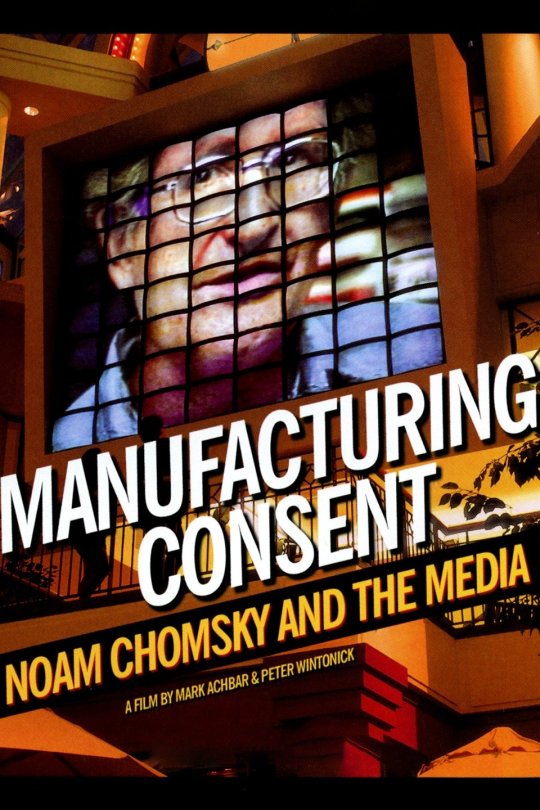
If you’ve ever seen the cover of the 1992 documentary “Manufacturing Consent: Noam Chomsky and the Media”, it is Chomsky’s face plastered across a large screen. A snapshot from one of the documentary’s opening scenes. I actually spent many moments of my childhood under that screen playing mini-golf, eating cake and other sugary goods, and taking unbearable photographs with Santa Claus.

Erin Mills today
This is the four-way screen that used to sit under the postmodern ‘town tower’ of Erin Mills Town Centre, also developed by Macklin Hancock. That tower is gone now, replaced by a strange glass globe, but the screen under that tower is forever emblazoned within that Chomsky documentary, and this piece of trivia is sometimes even featured in real-estate postings for the Erin Mills area.

The glass globe of Erin Mills today.
Following a quote by John Milton, the Chomsky documentary actually opens with overhead snapshots of Erin Mills Town Centre, before focusing in on the multimedia screen.





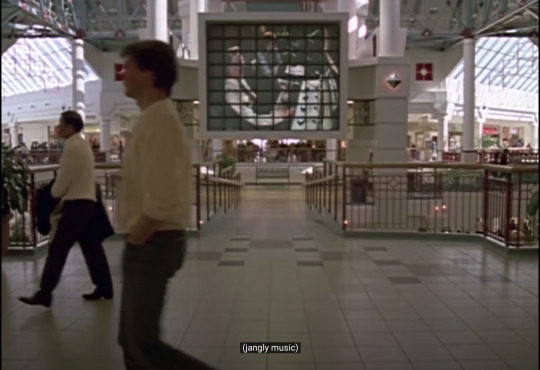
Opening screenshots from the documentary “Manufacturing Consent: Noam Chomsky and the Media”
Instead of collectively owned approaches to development, Macklin Hancock’s first ‘new town’ project (Don MIlls) was executed under the finance of a subsidiary owned by the arch-capitalist E. P. Taylor who also had his finger in every other industry of vice: alcohol, gambling, tar & chemicals, mining, gated communities, off-shore tax havens, and sugary soda drinks for children. Curiously, his brother Fred Taylor was an artist and a communist, constantly criticizing his brother, and who E. P. Taylor was perpetually embarrassed by.
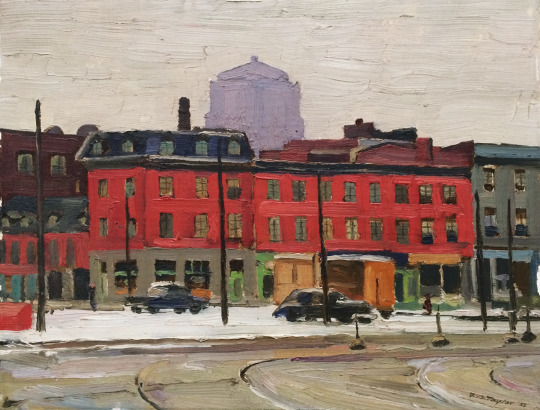
A painting of Chabolley Square, Montreal (1955) by the communist Fred Taylor (brother of arch-capitalist E. P. Taylor).
Hancock’s first job as a town planner came while he was still a graduate student at Harvard. His father-in-law worked for a company owned by E. P. Taylor and got Hancock to design a plan for what would become Don Mills. Hancock actually tried to convince his professors to allow him to undertake the project as extra credit towards his degree, but they declined, thinking he had bitten off more than he could chew. While on the project, he tried to convince one of his Harvard professors, Walter Gropius, to design the commercial heart of Don Mills ‘new town’, but Gropius “gently refused” as Dave LeBlanc put it in The Globe & Mail. Instead Gropius suggested another recent graduate of Harvard, John Parkin, who accepted the offer. Parkin would leave behind traces of Bauhaus design all over Toronto, and especially in the Don Mills area with buildings like Don Mills Collegiate and the Janssen Building.
Parkin was also involved in designing the Simpson’s building at Yorkdale Shopping Centre (now The Bay) together with Victor Gruen – the committed socialist often considered the ‘inventor’ of the shopping mall. Certainly shopping centres did not turn out to be the centres of civic community that Gruen initially envisioned. The young architect most responsible for the Simpson’s section of Yorkdale was actually John Andrews, who designed the CN Tower along with great brutalist landmarks like the University of Toronto Scarborough campus and the University of Guelph South Residence buildings. Andrews’ first job after graduating from Harvard was in the Parkin firm working on Don Mills. Afterwards, while working on the Simpson’s building at Yorkdale, he experimented in the vernacular of New Formalism, and I admittedly have a soft spot for those types of minimalist lines and the white vaulted ceilings that still adorn the exterior of The Bay. It’s probably my favourite decorative feature to Yorkdale. Andrews was actually drawing on the work of Minoru Yamasaki who was also working with the New Formalist vernacular at the time. Yamasaki is maybe most famous for designing the World Trade Towers, but he is also the architect behind the Pruitt-Igoe social housing complex. Catherine Liu, in a video interview with Jacobin, commented on how the destruction of Pruitt-Igoe and its condemnation by postmodernists (as a failure of top-down modernist ambition and idealistic design out of tune with the reality of the ‘gang violence’ that it would breed), was ultimately a mischaracterization of what amounted to a racist project by the white business class of defunding social housing primarily used by racialized communities.
Social housing was actually a central idea in the ‘new towns’ movement, but by the time it was taken up by Macklin Hancock around Toronto this was no longer a central focus. In fact one of the criticisms of Don Mills was its lack of non-profit housing. Anyway, after executing Don Mills rather ‘successfully’, to a fair degree of acclaim, he went back to Harvard to finish his degree. He would later go on to take these ‘new town’ ideas westward into Mississauga to develop both Meadowvale and Erin Mills along ‘new town’ principles. In fact, E. P. Taylor was one of the early speculators buying up land around the Missinihe (Credit River), which would eventually constitute part of the neighbourhood of Erin Mills.

The name Erin Mills itself was a sort of franchised extension of the success at Don Mills. The name was simply taken from nearby Erindale – ‘Erin’ being a mythic name for Ireland (since many of the early European settlers in the area hailed from Ireland), and dale was just another poetic name for valley (in this case, carved out by the Missinihe). There never was a historic mill site called ‘Erin Mills’ along the Missinihe as I had initially assumed. It’s actually quite interesting to see how settler colonialism is infused within the names developers gave to these ‘new suburban utopias’. It really begs the question ‘utopia’ for whom?
Thirteen years after purchasing all that land around the Missinihe, E. P. Taylor’s subsidiary Don Mills Development Corp announced a plan to build a New Town in four phases, and Macklin Hancock would be called back to the drawing table. Jan Dean tells the story along with the developer Larry Robbins in the Mississauga News:
“As Robbins tells it, the whole Erin Mills development – all four phases with all those thousands of homes and commercial and industrial buildings – started as a gleam in the eye of iconic Canadian entrepreneur E.P. Taylor. After the huge success of his Don Mills project Taylor dreamed of a similar project in the Credit River watershed. He started buying up parcels of land in the area, getting friends and colleagues to purchase it in their names to keep the prices down. And by 1954 Taylor’s company, Canadian Equity and Development Ltd. (CEDL) which also owned Don Mills Development Ltd. (DMD), owned 10,000 pristine acres of the watershed. It was a plot of land that Robbins describes as “a developer's dream where five creeks all flow into the Credit River in a south-easterly direction.” One third of the land was in Oakville, the other two-thirds in Toronto Township – what would become the City of Mississauga. “The land sold for $1,000 an acre,” says Robbins. “Now it would be worth more than $1-million an acre for raw land.””
The four quadrants of Don Mills and the same quadrant structure of Erin Mills Town Centre, to me, has certain thematic resonances with four rivers of the biblical Eden, and so the utopian allusion is certainly there, as I see it. But as I mentioned before, whose utopia was it? It is interesting that the nostalgic utopia this late capitalist development alludes to, that of ‘bucolic’ mills along the pastoral fields by the Credit River, was at the same time signifying a process that dispossessed the Anishinaabe who lived along the Missinihe. I did an audio piece on how the deforestation projects and decimation of salmon populations these mills perpetrated led to the exodus of the Anishinaabe as their livelihoods became endangered from the collapse of their resource base.

Lake Wabukayne
One interesting little body of water that I sometimes access along the network of walkways that Macklin Hancock designed in Meadowvale is known as Lake Wabukayne. It used to be a cattle pond on the Cook Farm, and became a flood control reservoir developed and financed by Cadillac Fairview for preventing surges of water, which could affect Erin Mills downstream of Wabukayne Creek.

An image of Wabukayne Creek (above) flowing nearby Erin Mills Town Centre, behind Quenippenon Meadows Community Park, named after another Anishinaabeg chief. His name is often rendered Kineubenae, Quinipeno, or Quenebenaw. He witnessed first hand British colonial deceit in the wake of signing Treaty 13A.

Concrete storm water management structure at Lake Wabukayne farther upstream in Meadowvale.
A note about the name of the creek and the reservoir: Chief Wabukayne was an Anishinaabeg leader murdered by a white man in Toronto who was trying to solicit sex from Wabuayne’s sister. And after this white man (a murderer of an Anishinaabeg Chief) was acquitted by the court, there was almost a full-scale indigenous insurrection resulting from the unjust ruling.

Erin Mills Town Centre today is owned by the Ontario Pension Board, but was previously owned and operated by Cadillac Fairview, which is in turn owned by the Ontario Teachers’ Pension Fund. David Harvey has pointed out the strange entanglements of capitalism, such that its less about which individual is a capitalist and who is proletariat, and more about the different roles people now play in different circumstances. Pensioners are capitalists, but I think there is some nuance here worth flushing out here.
The management consultant and business professor Peter Drucker in his 1972 book “The Unseen Revolution: How Pension Fund Socialism Came to America” opens his book by writing:
“If "socialism" is defined as "ownership of the means of production by the workers"—and this is both the orthodox and the only rigorous definition—then the United States is the first truly "Socialist" country.
Through their pension funds, employees of American business today own at least 25 percent of its equity capital, which is more than enough for control. The pension funds of the self-employed, of the public employees, and of school and college teachers own at least another 10 per- cent, giving the workers of America ownership of more than one-third of the equity capital of American business. Within another ten years the pension funds will inevitably increase their holdings, and by 1985 (probably sooner), they will own at least 50—if not 60—percent of equity capital. Ten years later, or well before the turn of the century, their holding should exceed around two-thirds of the equity capital (that is, the common shares) plus a major portion—perhaps 40 percent—of the debt capital (bonds, debentures, and notes) of the American economy. Inflation can only speed up this process.
Even more important especially for Socialist theory, the largest employee pension funds, those of the 1,000-1,300 biggest companies plus the 35 industry-wide funds (those of the college teachers and the teamsters for instance) already own control* of practically every single one of the
1,000 largest industrial corporations in America. This includes control of companies with sales well below $100 million, by today's standards at best fair-sized companies, if not actually small; the pension funds also control the fifty largest companies in each of the "non-industrial" groups, that is, in banking, insurance, retail, communications, and transportation.t These are what Socialist theory calls the "command positions" of the economy; whoever controls them is in command of the rest.
Indeed, aside from farming, a larger sector of the American economy is owned today by the American worker through his investment agent, the pension fund, than Allende in Chile had brought under government ownership to make Chile a "Socialist country," than Castro's Cuba has actually nationalized, or than had been nationalized in Hungary or Poland at the height of Stalinism.”
While this was in 1972, business elites still accept Drucker’s premise. For example, Roger L. Martin (former dean of Rotman School of Management) in a 2014 Harvard Business Review article agreed with Drucker:
“Workers, he predicted, would own the means of production — but not through the violent overthrow of capitalism in the way Marx had suggested. Rather they the ownership would come through the stocks held by their pension funds. Drucker was right, especially if you lump traditional pension funds along with their sovereign wealth fund cousins. The top 350 pension and sovereign wealth funds control just under $20 trillion of assets. They are the largest holders of securities in for-profit organizations competing in democratic capitalist environments.”
However, it’s worth considering how the ownership of these assets is not the same as democratic control over them. While this ‘pension fund socialism’ is hardly a threat to capitalism, and Drucker saw it as a saving grace of capitalism, Martin laments that these giant pension funds are monopolistic in nature and undermine capitalist competition. I am less interested in its undermining of capitalist competition (which I don’t perceive as a necessarily good thing), and more interested in how these monopolistic tendencies concentrate power. The Egyptian Marxist Samir Amin writes:
“The logic of accumulation lies in the growing concentration and centralization of control over capital. Formal ownership can be spread out (as in the “owners” of shares in pension plans), whereas the management of this property is controlled by financial capital.”
I think this is an important point, because I often ponder the difficult struggle over divesting university pension funds and similar types of investments out of fossil fuels. What degree of democratic control exists in the allocation of capital? Samir Amin believes that ultimately a de-financialisation of economic management is required, and elaborates on how abolishing pension funds is a necessary step towards this goal:
“The de-financialisation of economic management would also require two sets of legislation. The first concerns the authority of a sovereign state to ban speculative fund (hedge funds) operations in its territory. The second concerns pension funds, which are now major operators in the financialisation of the economic system. These funds were designed - first in the US of course - to transfer to employees the risks normally incurred by capital, and which are the reasons invoked to justify capital‟s remuneration! So this is a scandalous arrangement, in clear contradiction even with the ideological defense of capitalism! But this “invention” is an ideal instrument for the strategies of accumulation dominated by monopolies. The abolition of pension funds is necessary for the benefit of distributive pension systems, which, by their very nature, require and allow democratic debate to determine the amounts and periods of assessment and the relationship between the amounts of pensions and remuneration paid. In a democracy that respects social rights, these pension systems are universally available to all workers. However, at a pinch, and so as not to prohibit what a group of individuals might desire to put in place, supplementary pensions funds could be allowed. All measures of de-financialisation suggested here lead to an obvious conclusion: A world without Wall Street, to borrow the title of the book by François Morin, is possible and desirable.”
I think Peter Frase also provides a really interesting critique of this sort of ‘market socialism’ framing, even mentioning Peter Drucker explicitly. Frase first cites something Matt Yglesias writes in reference to the Singaporean sovereign wealth fund:
“[T]he right thing to do is to just directly think about the issue of how best to ensure that everyone obtains the financial benefits of equity investments. And the answer, I think, is sovereign wealth funds. That’s how they do it in Singapore and conceptually it’s the right way to do it. An American version of Singapore’s Central Provident Fund would be much too large for any market to absorb, but the US share of world GDP should shrink over time and it’s conceivable that there would be some way to work this out on the state level to create smaller units. A fund like that would render the public listing issue irrelevant, since it would clearly have the scale to get in on the private equity game. This would, needless to say, entail injecting a hefty element of socialism into American public policy but I’m always hearing from smart conservatives how much they admire Singapore.”
After citing this remark by Yglesias, Frase lists out all the problems that still remain with this sort of ‘market socialism’:
“you would still have profit-seeking companies competing with each other, and they would still be subject to the same kind of discipline they are now--the shareholders, which is to say the sovereign wealth funds, would demand the highest possible return on their investment… the important point about capitalism without capitalists is that in many ways it isn't any better than capitalism with capitalists. You still have to sell your labor power and submit to a boss in order to survive, so alienation persists. Since firms are still competing to deliver the highest returns to their shareholders, there will still be pressure to exploit employees more intensely and to prevent them from organizing for their rights. Exploitation goes on as before, and it will be all the more robust insofar as it is now a kind of collective self-exploitation. And on top of all of this, the system will still be prone to the booms and busts and problems of overaccumulation that occur in today's capitalism. It was, after all, public and union pension funds that bought many of the toxic mortgage-backed securities during the housing bubble.
…now each person is simultaneously a capitalist and a worker, in some degree or for some part of their life. Thinking through the inadequacy of such an arrangement is, for me, a more accessible way of thinking through the arguments of people like André Gorz and Moishe Postone. They argued that the point isn't to get rid of the capitalist class and have the workers take over: the point is to get rid of capital and wage labor.”
I started this long tangent on pension funds remarking that it was Cadillac Fairview that owned and operated Erin Mills Town Centre and even a lot of the surrounding infrastructure (like the flood-control reservoir of Lake Wabukayne in Meadowvale). I found it a very curious thing that it was the Ontario Teachers’ Pension Plan who owned Cadillac Fairview. My mom works in finance, and many of the people in the corporation she works for come from OTPP, because they are totally woven into the fabric of Canadian high finance just as any other capitalist financial corporation. It’s remarkable that Cadillac Fairview actually owns the entire TD Centre out of which the Toronto Dominion bank operates out from. This is maybe the most significant Bauhaus architectural landmark in the downtown core of Toronto designed none other than Ludwig Mies Van der Rohe.
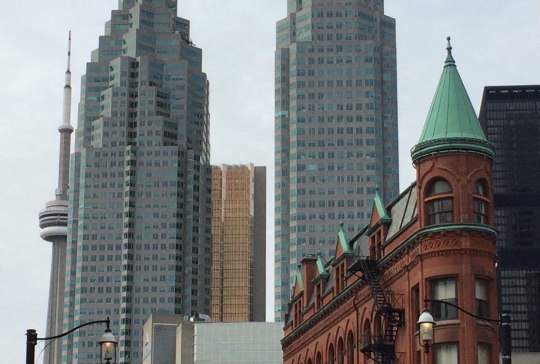
I swear there is a better photo I took of this building, but this is the only one I could find for now. The Mies TD Centre building is the black one on the far right.
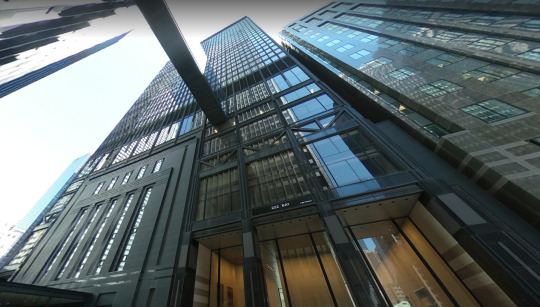
This is a shot of it I snagged from google maps.
Mies Van der Rohe is possibly one of the most well known of the Bauhaus architects, and the last director of the Bauhaus school, an institution with a stormy connection with the left. In 1926, Mies Van der Rohe had designed a memorial to the communist ‘martyrs’ of the German revolution, Spartacist League leaders Rosa Luxemburg and Karl Liebknecht, commissioned by the then president of the German Communist Party, Eduard Fuchs. This memorial, with its hammer and sickle and all, had been later destroyed by the Nazis, whom Mies Van der Rohe had capitulated to in strides and bounds, trying to keep the doors of the Bauhaus school open, but eventually failed. Mies had gone so far as to make submissions for Third Reich buildings like their Reichsbank competition and their pavilion at the Brussels World’s Fair, complete with sketches of swastika flags and a stone eagle. By 1937, the Bauhaus school had shuttered and Mies left for the US. This trajectory was what led Mies to design some of the most famous modernist skyscrapers plastered with the names of large corporations and banks – exactly as one sees with the TD Centre at the heart of the Toronto financial district. The architectural critic Tom Dykhoff writes:
“…his future patron would be no government, no political system, but the economic system that was emerging triumphant in the US. Modernism…would succeed as the landscape not of communism, bolshevism or nazism, but of international capitalism.”
The Bauhaus school before Mies Van der Rohe had a reputation, especially among the Nazis for being infiltrated by all sorts of leftist elements, particularly communists. It might be worth taking a moment here to describe what was the Bauhaus movement in fact was and a bit about its founder – Walter Gropius, the Harvard professor who had greatly influenced Macklin Hancock during his time in Cambridge, Massachusetts.
The Irish communist Jenny Farrell wrote a great introduction to Bauhaus for People’s World:
“The Bauhaus began in Weimar in 1919 as a state school for art and architecture. The guiding principles in the Bauhaus Manifesto were community, unity of art, practical education, cooperation between craft and industry, and a sense of belonging to the people. All artistic disciplines were to be reunited under the leadership of a new architectural art.
The name Bauhaus plays on the German word Bauhütte (construction/building hut)—the workshop where the builders of the great medieval cathedrals worked together: quarrymen, plasterers, mortar-makers, stone-cutters, masons, and others. Here there were no strict dividing lines between artists and craftsmen, and the builders were both in one. This was an important concept for the Bauhaus school. As the word Hütte means hut, the term was modernized to Haus (house). In this way, the term Bauhaus refers to a workshop, the sense of community and the equality of art and craft under the guidance of architecture, as cultivated in medieval cathedral workshops.”
The medievalist impulses of Morris’s Arts & Crafts movement deeply informed the early Bauhaus before its direction towards more futurist and urban aesthetics. J. Dakota Brown in a Jacobin article writes:
“The cover of the Bauhaus’s founding manifesto carried Lyonel Feininger’s woodcut of a cathedral rising into a turbulent sky, beset by shafts of light. In the writings of Arts and Crafts theorists like John Ruskin and William Morris, the Gothic cathedral had represented the integration of art, labor, and life in the pre-capitalist world. Bauhaus pedagogy reimagined the structure of the medieval guilds: “apprentices” worked under a “master of form” (normally a painter) and a “master of craft” (a skilled artisan). Students who passed the initial coursework became “journeymen” eligible for waged work in the workshops. Many later became “young masters” — junior teachers — themselves. The Bauhaus Manifesto promised to “raze the arrogant wall between artist and artisan” through a dual education that would form a new type of producer.”

An Arts & Crafts Movement display at the Royal Ontario Museum.
This medievalism of the Bauhaus school in fact did find its way into the work of Macklin Hancock in Don Mills, although Hancock’s other influence of ‘new towns’ were also deeply informed by the work of William Morris. The president of Don Mills Residents Inc., Tony West, explains:
"Most European towns start with a castle and then outside you had people with dwellings and the fields where people work.”
In the case of Don Mills it is the shopping centre that serves the role of the medieval castle, which ironically seems a fitting way to frame the feudalistic nature of capitalist consumerism. Around this castle are the four quadrants of Don Mills, each with a school, church and housing – all of which connected by a network of walkways (as I see in Meadowvale also). The Donway then is often framed as the ‘medieval wall’ wrapping around the Don Mills ‘new town’.

However, Bauhaus’s coalescence of building and architectural design was ultimately rejected by many of the architects and planners around Macklin Hancock, as they saw the architect as an importantly neutral mediator between the developer and the builder – again willing to forsake core design principles for the sake of maintaining the terms of capital. I am not sure about Hancock’s take on Gropius, but it is interesting some of the remarks made in an issue of the Royal Architectural Institute of Canada (Serial No 341, Vol. 31, No. 1) that featured an article by Macklin Hancock and his colleague Douglas Lee called “Don Mills New Town”. It opens with an editorial by the President saying:
“The very fact that imagination has been freed and traditional restraints removed is making us more soberly thoughtful, more critical of new forms of expression, less apt to mistake novelty for beauty, less willing to accept the philosophies of contemporary prophets without fully understanding them… It is suggested sometimes that the architect should abandon his professional status and take part commercially in the building operation. This we must not do. The professional function of the architect is vital to the orderly operation of the business of building.”
Later in the issue, from Alberta, the architect Maxwell Bates writes:
“In the United States, Dr Gropius recently said that the architect will have to become part builder to survive… At first glance, the combination may seem healthy and natural, but I think consideration shows it to be extremely dangerous. Although the position of the architect, internationally speaking, has suffered some modification in our century, it has gradually evolved, without great basic changes, for hundreds of years. His position has depended on a relative independence as between owner and builder on the one hand, and a general acknowledgement of architecture as an art, even as the mother of the arts, on the other hand. The architect is the only side of the owner, architect, builder triangle able to make impartial judgments. On this impartiality, which corresponds in a way with the independence of the judiciary from party politics, depends the respect with which he has been generally regarded by the building trades. Much of his authority on the job is traditional. To become party to a building contract is to lose all eminence due to his professional, impartial standing. So the English architect foresees the architect becoming less of an artist; and the famous architect, Dr Gropius, foresees the necessity of relinquishing his other traditional support, his independence as mediator between contracting parties.”
I wonder what Hancock thought of this, and I wonder if these remarks were specifically targeted at Hancock, and consequently published together with his Don Mills article. Certainly, whatever their concerns, Hancock still fit very well into the capitalist arrangement (’mediating between contracting parties’) as he wrote with Lee in his article on Don Mills New Town:
“It is the aim of the Development Company to create, under the free enterprise system, an integrated new town which will satisfy the requirements of private investment, and which will also be in accordance with the best principles of town planning.”
It’s clear Hancock thought he could pull off both. I think it’s interesting now to take a closer look at Walter Gropius who so influenced Hancock, and the sort of leftist currents that he was moved by. I think this is why Hancock is always being found to emphasize terms like “free enterprise” and “private investment” as people like Gropius were often seen as socialists, and for good reason. Jenny Farrell talks about the ‘Cathedral of Socialism’ that was featured on the front page of the Bauhaus founding manifesto:
“With this commonality of craft and art in medieval cathedral construction in mind, the “Cathedral of Socialism” was understood as a utopian building and embodiment of a future social structure, intended to overcome the consequences of alienation, the causes of which were seen more in the division of labor than in wage labor.
Walter Gropius added this woodcut by Lyonel Feininger to the founding manifesto of the Bauhaus in 1919 as the title page. A triad surrounds the cathedral spire: the three arts of painting, sculpture, and architecture, their rays flowing into each other. The choice of cathedral references the Bauhütte and underlines the centrality of architecture. The old-fashioned woodcutting technique combines with a futuristic cubist design.”

Lyonel Feininger‘s “Cathedral of Socialism”
It’s actually worth seeing the way Tom Wolfe, the arch-reactionary journalist, talks about Gropius and the Bauhaus movement in general. I actually bought one of his books “From Bauhaus to Our House” from a used bookstore during my first year in Kingston. I did not really know who Tom Wolfe was at the time, but I was somewhat interested in the Bauhaus movement. Little did I know the book would be a weird anti-socialist tirade. It’s fascinating the way Wolfe yearns with nostalgia for a time when rich aristocratic families with taste commissioned classical re-renderings all over the city, but now, corporate bodies have to accept modernist architecture as a slap across the mouth:
“…after 1945 our plutocrats, bureaucrats, board chairmen, CEOs, commissioners, and college presidents undergo an inexplicable change. They become diffident and reticent. All at once they are willing to accept that glass of ice water in the face, that bracing slap across the mouth, that reprimand for the fat on one’s bourgeois soul, known as modern architecture.”
Wolfe then quotes a manifesto of the Novembergruppe, of which Gropius was chairman, which states:
“Painters, Architects, Sculptors, you whom the bourgeoisie pays with high rewards for your work—out of vanity, snobbery, and boredom—Hear! To this money there clings the sweat and blood and nervous energy of thousands of poor hounded human beings—Hear! It is an unclean profit …we must be true socialists—we must kindle the highest socialist virtue: the brotherhood of man.”
Wolfe next quotes Gropius speaking on the class commitments of the Novermbergruppe’s Workers’ Council for Art (i.e. ‘Soviet’ for Art):
“The intellectual bourgeois … has proved himself unfit to be the bearer of a German culture… New, intellectually undeveloped levels of our people are rising from the depths. They are our chief hope.”
Jenny Farrell includes this Gropius quote in her People’s World article for the centenary of the Bauhaus school’s founding:
“In Gropius’s words: ‘the more their class pride grows, the more the people will despise imitating the rich and independently invent their own style of living. This understanding by the people is the fertile ground for the art to come.’”
Yet Gropius would actually turn out to be a moderating force in the Bauhaus school who would curtail the more radical communist direction that Hannes Meyer brought the Bauhaus school towards after he was appointed director of the school after Gropius. J. Dakota Brown gives a fascinating account of this story:
“Years of political wrangling had delayed many of Gropius’s plans, but the institution seemed to be on secure footing when he abruptly announced his departure in 1928. Gropius offered the directorship to Hannes Meyer, hired the previous year to head the architecture department… The Bauhaus would now be oriented toward “necessities” rather than “luxuries,” centering the needs of the proletariat. Design problems would take their cues less from formal exercises directed by painters, and more from current research in the natural and social sciences.
Departing from the official position that the Bauhaus was engaged in “objective, entirely non-political cultural work,” Meyer was open in his communist sympathies. He rearranged the class schedule to more closely approximate an industrial workday and happily reported that increased cohesion and cooperation during his directorship signaled “an undeniable degree of proletarianization.” Under Meyer, a growing body of communist students came to understand the Marxist worldview as the only consistent outcome of a Bauhaus education.
Trade union facilities and workers’ housing completed under Meyer, after all, had clear precedents in projects initiated by Gropius — who once defended his own generous master’s quarters by saying, “what we today consider luxury will tomorrow be the norm!” In the background, however, Gropius, Kandinsky, and Josef Albers were already plotting Meyer’s dismissal.
Meyer’s political sympathies naturally attracted controversy. Bauhaus students were overheard singing communist songs at a 1930 party, which produced a feeding frenzy in the right-wing press. Later, it came to light that Meyer and a Bauhaus student group had each donated money to a Communist-led miner’s strike.
Attempting to stem the formation of a fully-fledged “communist cell” at the Bauhaus, the masters dismissed twenty students in a move that made Meyer himself a target of student anger. Nonetheless, the liberal mayor of Dessau — encouraged by Gropius and the old masters (with the exception of Klee) — demanded his resignation.
A few months later, Meyer boarded a train to Moscow with several of his closest students. Stalinist policy on design and architecture, however, would prove hostile to Meyer, who rounded out the rest of his career as a city planner in Mexico. Over the next decades, Gropius and the remaining masters would construct a canonical version of the Bauhaus that erased Meyer’s contributions altogether.”
After Meyer was removed from the Bauhaus directorship, Mies van der Rohe took leadership, and there was a significant political shift that accommodated the fascist pressure of the Nazis.
It’s remarkable to see how entangled leftist politics was in both the work of Gropius and the Bauhaus school in general, and to think it was a major influence on Macklin Hancock’s plan for Meadowvale, the sleepy Mississauga suburb where I live that exists on the very fringes of the city, only minutes from farm land that still covers many land plots in Milton.
Yet even more than Gropius and the Bauhaus movement, the other professor at Harvard that had a great influence on Macklin Hancock was William Holford, who spent much of his career spreading the ideas of the ‘new town’ movement. Macklin Hancock ultimately called Don Mills, Erin Mills, and Meadowvale ‘new towns’ because those were the design principles he was principally informed by. There is less information on Holford out there than Gropius, but I actually find Holford even more interesting. However, before going into Holford, it might be worth tracing out what the ‘new town’ movement was.
youtube
Charley cartoon commissioned by post-war Labour government to promote their New Town plan. The film was created at the behest of Stafford Cripps (UK’s ambassador to the Soviet Union and once leading spokesman for the Popular Front with the Communist Party which got him expelled from the Labour Party).
Professor Georgia Wrighton, on a Monocle episode on ‘new towns’ provides an excellent introduction sketching out the post-war history of this movement in the UK, locating its origin in the ‘garden city’ movement which tried to combine ‘town’ and ‘country’, in a way that brought the imagined healthiness of the ‘countryside’ into the town’ for an elevated quality of life. Wrighton specifically mentions the “radical new Labour government under Atlee” planning ten satellite towns around London to deal with the housing crises after WW2 and house “bombed out Londoners” in such a way that dealt with the earlier problems of development under the industrial revolution – namely disorganized and unplanned development, overcrowding, and pollution. The early policies of these ‘new towns’ involved affordable rentals for the working class, as well as mixed-class housing to prevent class stratification and segregation. One of the most important features was that the increased value of the land from the ongoing building of the new towns was to go back into the ‘new town’ for maintenance and renewal. Wrighton describes an early feeling of a “socialist utopia being built in the brave new world of the 1945-era”, but by the late fifties, the invisible hand of the private market began creeping into these developments, such that the early model of land value uplift going into ‘new town’ refurbishment was abandoned as the privatization model of the late fifties involved selling off the land into private hands. All that remained was the council housing which had to find alternative revenue streams.
This model that Wrighton discusses is explicitly spelled out in the ‘garden city’ principles of Ebenezer Howard, who often rubbed shoulders with other anarchists and socialists. This model though was actually a Georgist one. Henry George had formulated a similar idea where the rising value of land would be reabsorbed by the public through a land value tax, that prevented people from profiting of the mere possession of land and recapture the collective’s common inheritance. Though Howard had drawn on people even more radical than George. In 1889, Edward Bellamy the socialist novelist had his book “Looking Backward” first published (serially) in the journal Brotherhood edited by J. Bruce Wallace. There’s a fascinating connection between Wallace and the Bolsheviks that I will get into soon. But Bellamy’s novel would make a significant impression on Howard after his first reading of it, although he became more sceptical about it in later readings. Like William Morris, he was mainly concerned with the idea of the state becoming one large capitalist corporation that replaced all other capitalists and all the centralized bureaucracy that would entail (although this is not actually that far from the process Engels describes in “Socialism: Utopian and Scientific” and which is more recently explored in books like “The People’s Republic of Walmart”, and this gets back to Drucker’s ‘pension fund socialism’ I was discussing earlier). However, other aspects of Bellamy’s novel would persist in its influence on Howard.
In addition to the obvious influence of William Morris, another interesting figure that left traces in Howard’s work was Kropotkin. Howard briefly cites Kropotkin’s book “Fields, Factories and Workshops” in the second edition of his seminal work “To-morrow: A Peaceful Path to Real Reform” – though what Howard was interested in was not the revolutionary aspects of Kropotkin, but those of local initiative and self-government.
The first planner to put Howard’s principles into practice was Raymond Unwin who planned Letchworth, often called the first garden city. Unwin was both an engineer and a town planner who spent much of his life trying to improve working class housing. He was friends with the socialist Edward Carpenter, interested in John Ruskin, and deeply committed to the Marxism of William Morris – even moving to Manchester to become secretary of Morris’s Socialist League and editing its newspaper. He was also very involved in the Labour Church, which was one of the primary forces of Christian socialism at the time.
Letchworth became the site of Britain’s first roundabout. The Yale professor James C. Scott, interprets “traffic circles” as a sort of anarchist assemblage that replaces the centralized control of traffic lights, with a self-managed traffic junction that has proven to actually be more efficient and safer in a number of contexts. In his book “Two Cheers for Anarchism”, Scott briefly discusses various “red light removal” campaigns in Europe and some impressive results of their implementation .
Letchworth, and ‘garden cities’ more broadly, would become a deeply influential in the town planning of both Cold War super powers. I personally find the influence of ‘garden cities’ on Soviet planning to be particularly interesting. Rosemary Wakefield, in her fascinating book on ‘new towns’ called “Practicing Utopia” writes:
“The garden city concept was introduced into Russia by 1908, and social reformers in Saint Petersburg published a Russian translation of Howard’s text in 1911. A small party of Russians made the pilgrimage to Letchworth in 1909 with German garden city enthusiasts, and again in 1911 with a Danish and German delegation. The infl uential Russian architectural journal Gorodskoe Delo eagerly promoted garden city ventures, while architect Vladimir Semionov worked with architect and urban reformer Raymond Unwin in England and wrote extensively on garden city ideals. Based on Semionov’s design, the Moscow- Kazan Railway Company began construction of Russia’s first model garden city at the Prozorovskaia Station, forty kilometers east of Moscow. It was such a success that the Russian Ministry of Transport began building similar settlements for railway employees. Garden city– style projects popped up in Siberia, where an All- Russian Garden Cities Society was founded.”
The Soviet planner Semionov that Wakefield mentions actually ended up planning major Soviet cities like Kharkov and Stalingrad, drawing on Howard’s ‘garden city’ principles. Wakefield describes a fascinating debate that unfolded within Soviet planning circles between urbanists and disurbanists (which included enthusiasts of ‘garden city’ principles that influenced Macklin Hancock, as well as ‘linear city’ principles which influenced Moshe Safdie’s unrealized Meadowvale proposal). Wakefield on the debate:
“A passionate debate ensued on the nature of the sotsgorod, or socialist city, as the Soviet Union hurtled into urban and industrial transformation. The battle was initially drawn between two camps: the disurbanists, who argued for decentralization mostly following the garden city ideal, and urbanists, who demanded an increased scale of urbanization and industrialization.
Linear industrial towns were proposed by El Lissitzky and by Nikolai Miliutin, especially the latter as outlined in his seminal publication The Problem of Building Socialist Cities (1930).19 The linear city had political appeal, because it seemed to abolish the division between city and country according to the principles outlined by Karl Marx. Miliutin produced such plans for the new industrial towns of Magnitogorsk in the Urals, Stalingrad on the Volga River, and Avtozavod, where an automobile plant was taking shape under the direction of Ford Motor Company. Parallel industrial and residential strips were separated by greenbelts and highways. The towns would be nodes along transportation routes in one continuous band of development. Miliutin’s groundbreaking concepts were published in Ernst May’s Das Neue Frankfurt and were featured in the Proletarian Building Display in Berlin in 1931.20 The linear city ideal survived as one of the most viable alternatives to the concentric pattern of garden and satellite cities.”
Another fascinating Soviet connection involves a rumour (an urban myth, or rather a ‘garden city’ myth) that Lenin actually visited Letchworth during his time in London in 1907 for the 5th Congress of the Russian Social Democratic Labour Party, attended also by other Russian revolutionaries like Rosa Luxemburg, Trotsky, Stalin, and Maxim Gorky. The congress was hosted in Hackney at a Tolstoyan socialist church called the Brotherhood Church, founded by J. Bruce Wallace, a resident of Unwin’s Letchworth garden city. Wallace was actually the first to publish Bellamy’s novel in serialized form in his journal of the same name – Brotherhood. Gorky described the Brotherhood Church thus:
“I can still see vividly before me those bare wooden walls unadorned to the point of absurdity, the lancet windows looking down on a small, narrow hall which might have been a classroom in a poor school.”
Part of the Lenin in Letchworth rumour involves Wallace possibly hosting Lenin for a night in Letchworth, where Lenin also allegedly gave a talk. There is a fascinating BBC Radio 4 episode on this idea of Lenin visiting Letchworth. In Robert Beevers' book "The Garden City Utopia", there is an interesting endnote that he includes:
“[the] Letchworth branch of the Social Democratic Federation was in touch with the R.S.D.L.P. Congress, as is indicated by the fact that it passed a resolution protesting at the harassment of its delegates by the police, vide The Citizen, 20 July 1907.”
Russian revolutionaries garbed in funny-looking disguises and set on overthrowing the tyrannical Czar, gathered in Wallace’s Brotherhood Church, for three weeks, and were subject to jeering protestors as well as curious onlookers. The BBC programme on Lenin in Letchworth has a fascinating excerpt written by Kruspskaya (Lenin’s wife) from an earlier visit to London with Lenin in 1902-1903 describing their visits to various socialist churches. She writes of Lenin:
“He visited eating houses and churches. In English churches the service is usually followed by a short lecture and a debate. Ilyich was particularly fond of those debates, because ordinary workers took part in them. He scanned the newspapers for notices of working-class meetings in some out-of-the-way district, where there were only rank-and-file workers from the bench – as we say now – without any pomp and leaders. These meetings were usually devoted to the discussion of some question or project, such as a garden-city scheme. Ilyich would listen attentively, and afterwards say joyfully: "They are just bursting with socialism! If a speaker starts talking rot a worker gets up right away and takes the bull by the horns, shows up the very essence of capitalism." It was the rank and-file British worker who had preserved his class instinct in face of everything, that Ilyich always relied upon. Visitors to Britain usually saw only the labour aristocracy, corrupted by the bourgeoisie and itself bourgeoisified. Naturally Ilyich studied that upper stratum, too, and the concrete forms which this bourgeois influence took, without for a moment forgetting the significance of that fact. But he also tried to discover the motive forces of the future revolution in England.
There was hardly a meeting anywhere we did not go to. Once we wandered into a socialist church. There are such churches in England. The socialist in charge was droning through the Bible, and then delivered a sermon to the effect that the exodus of the Jews from Egypt symbolized the exodus of the workers from the kingdom of capitalism into the kingdom of socialism. Everyone stood up and sang from a socialist hymn-book: "Lead us, O Lord, from the Kingdom of Capitalism into the Kingdom of Socialism." We went to that church again afterwards – it was the Seven Sisters Church – to hear a talk for young people. A young man spoke about municipal socialism and tried to prove that no revolution was needed, while the socialist who had officiated as clergyman during our first visit declared that he had been a member of the party for twelve years and for twelve years he had been fighting opportunism – and that was what municipal socialism was – opportunism pure and simple.”
The BBC programme also shares an excerpt from Orwell’s classic “The Road to Wigan Pier” (a book I’ve even seen Marxist-Leninists approve of), that offers up a brutally derisive account of Letchworth:
“One sometimes gets the impression that the mere words ‘Socialism’ and ‘Communism’ draw towards them with magnetic force every fruit-juice drinker, nudist, sandal-wearer, sex-maniac, Quaker, ‘Nature Cure’ quack, pacifist, and feminist in England. One day this summer I was riding through Letchworth when the bus stopped and two dreadful-looking old men got on to it. They were both about sixty, both very short, pink, and chubby, and both hatless. One of them was obscenely bald, the other had long grey hair bobbed in the Lloyd George style. They were dressed in pistachio-coloured shirts and khaki shorts into which their huge bottoms were crammed so tightly that you could study every dimple. Their appearance created a mild stir of horror on top of the bus. The man next to me, a commercial traveller I should say, glanced at me, at them, and back again at me, and murmured ‘Socialists’, as who should say, ‘Red Indians’. He was probably right—the I.L.P. were holding their summer school at Letchworth. But the point is that to him, as an ordinary man, a crank meant a Socialist and a Socialist meant a crank. Any Socialist, he probably felt, could be counted on to have something eccentric about him. And some such notion seems to exist even among Socialists themselves. For instance, I have here a prospectus from another summer school which states its terms per week and then asks me to say ‘whether my diet is ordinary or vegetarian’. They take it for granted, you see, that it is necessary to ask this question. This kind of thing is by itself sufficient to alienate plenty of decent people. And their instinct is perfectly sound, for the food-crank is by definition a person willing to cut himself off from human society in hopes of adding five years on to the life of his carcase; that is, a person but of touch with common humanity.”
Orwell can truly be so insufferable sometimes. As Orwell famously spent much of his youth as a colonial police officer in Burma, I think it’s rather rich to hear him criticize other people in the fashion he does. While on the topic of Southeast Asia, it’s worth making a small detour regarding the influence of ‘garden city’ principles in one ‘non-aligned’ country before proceeding onto its influence in America.
As most of my extended family lives in Singapore, and I have visited them a handful of times, I’m quite aware of the way Singapore often refers to itself as The Garden City – a branding inaugurated under the young Lee Kuan Yew, at that time a Fabian socialist from his time in Cambridge throughout the early decades of his political career. Architectural critics have made much of Le Corbusier’s influence on early Singapore development and planning. Le Corbusier was of course rather taken with Howard’s “garden city” ideas and many of his design plans show that greening influence.

WOHA building behind Hong Lim Park (where expressions of dissent are contained) in Singapore.
I’m less interested in Le Corbusier, a notorious anti-Semite and as far as I’m concerned – a fascist. However, I am interested in the rationale behind Lee Kuan Yew’s insistence on making Singapore into a ‘garden city’. Part of it was making life more pleasant for the people who lived on this tiny Southeast Asian island, but it seems the central focus was attracting foreign investment and tourists. So the ‘magnet’ Ebenezer Howard wrote of, was maybe less about attracting people (unless they were tourists) and more about making the island more conducive to capital, which is not wholly distant from the sort of ideas prevalent throughout a lot of Fabian reformist socialism. I have not been able to locate any explicit references to Ebenezer Howard in early Singaporean state planning policy, but would be fascinated if anything on that were to come up in the future.
It is worth commenting that Moshe Safdie (who worked on the proposal for Meadowvale as his thesis project) was the architect behind Singapore’s iconic Marina Bay Sands building, the second most expensive building at the time of its completion. The irony that a socialist would not only build such an extravagant building but that it was also a casino resort has not been lost on me. Utopian socialist design can almost never succeed in progressing its core political principles under capitalism.
As for the influence of ‘garden cities’ in the US, the beating heart of capital, I will turn to Rosemary Wakefield to explain how Unwin and Howard worked together with Clarence Stein, a progressive planner that would become influential on American suburban design, and greatly influence Macklin Hancock:
“The American interpretation of garden cities is equally illustrative of the fusion of influences comprising both the new town birthright and the regional vision that framed it. In 1923, Clarence Stein and Henry Wright sailed for England to meet with Ebenezer Howard and Raymond Unwin and make the pilgrimage to Letchworth, Hampstead Garden Suburb, and the newly established Welwyn Garden City. The experience was clearly the inspiration for the “city planning atelier” that Stein organized to discuss how the garden city could fi t the needs of America. He and Wright persuaded Unwin to help shape the group’s theoretical framework, with the result that Unwin became actively involved in the American planning scene.”
Stein’s Radburn was an explicit influence for Hancock. While Stein offered some interesting ideas that kept with the ‘garden city’ tradition – like reducing the size of private yards to produce greater public spaces, facing house fronts onto these green public spaces and placing garages at the back of hosues where they would lead directly into house kitchens, as well as important greenbelting measures – despite all this, Stein did not retain the same socialist impulses as Howard or Unwin, and never did claim the label of socialist as such. Even still, he was very critical of capitalism believing:
“(a) the revolution was at hand, and (b) capitalism could not and perhaps should not survive. He expressed his political views quite openly in these letters.” (in the words of Tridib Banerjee)
Prudence Anne Phillimore described Stein’s relationship to capitalism in this way:
“He also appealed to people to reject the waste and extravagance that had become an integral part of life in a capitalist society. Although Stein did not venture as far into socialism, he was vitally concerned to find a means of eliminating the unnecessary waste which comes from our system of competitive production and distribution, " and to remove 22 staples, like housing, from the competitive market. Both the economical use of land and the control of unearned increment on land (through single ownership) and the aesthetics of city planning became focal points In Stein’s work.”
Despite holding onto this Georgist idea from the ‘garden city’ movement Stein was disturbingly accommodating to segregationist policies. Andreas Panagidis in a case study on Radburn writes:
“as the planners were trying to comprehensively design the neighbourhood, they were also posing segregationist questions such as “what should be the policy in relation to the admission of negroes and other people of other races than white?” (Stein cited in Birch, 1980), and by the eventual racial discrimination by the realtors of both Jews and African-Americans (Schafer, 1983). The residents' educational and religious backgrounds would end up being “more or less the same” (Stein, 1949).”
Another influence of Hancock, this time concerning the placement of a shopping mall as the ‘town centre’ of a ‘new town’, was the planner and mortgage banker James Rouse, another ‘new town’ planner, but one far less anxious about capitalism. He was a philanthropist and advocate for ‘free enterprise’ economies. Freedom for whom? People with money, to do what they want with their money. While Rouse spoke the rhetoric of racial equality saying:
"The ultimate purpose, it seems to me, must be the improvement of mankind," he wrote. "There really can be no other end purpose of planning except to develop better people….An inspired, concerned and loving society will dignify man; will find the ways to develop his talent; will put the fruits of his labor and intellect to effective use; will achieve brotherhood; eliminate bigotry and intolerance; will care for the indigent, the delinquent, the sick, the aged; seek the truth and communicate it; respect differences among man."
Paige Glotzer in her book “How the Suburbs Were Segregated” gives a more sobering account of Rouse’s involvement in networks of segregationist developers:
“In Baltimore, one of the most prominent developers to gain power in the 1960s was James Rouse. Rouse was a self-described liberal whose politics and development priorities seemed, on the surface at least, to constitute a considerable break with predominant exclusionary patterns. However, Rouse’s rise is precisely why a longer history of suburban power is necessary to understand the persistence of housing segregation. Indeed, Rouse was a part of the Roland Park Company network. Before he became famous as a developer in the 1960s, Rouse began his career in the Baltimore office of the FHA and worked closely with Roland Park Company officials in business endeavors and government consulting. By the 1950s, Rouse and Mowbray together were in charge of spearheading federal urban renewal policy based on their work in Baltimore. This policy ultimately wreaked devastation on communities throughout the country. In Baltimore alone, urban renewal displaced over ten thousand households. As was the case around the country, the majority of those who lost their homes were African American.
Often lauded both for his malls and for the racially integrated planned suburb of Columbia, Maryland, well outside Baltimore, Rouse’s early and midcareer work consisted of fortifying the very socioeconomic and racial borders that the Roland Park Company had created. Nowhere was this clearer than in Cross Keys in the early 1960s, where Rouse developed a gated planned community next to Roland Park called the Village of Cross Keys after urban renewal destroyed the long-standing African American community of the same name.”
Glotzer’s work on redlining is important for underscoring how planning communities under a capitalist economy, despite the radical ideas you bring to the table will inevitably devolve to accommodate the dictates of capital – if developers consider the uplift of property value a paramount consideration, than segregation becomes a justifiable means of achieving it. While suburbs in the US have become symbols where white families escape to from inner cities to live lives segregated from other racialized families – suburbs around Toronto have become havens for immigrant communities. Peel Region, where both Meadowvale and Erin Mills are located in, has the highest percentage of ‘visible minorities’ in the GTA (at 62.3%). In fact, 50.8% of Peel’s population is of South Asian ancestry, making the term ‘visible minority’ a clumsy one at best. Yet racial diversity is not a barometer for a just economy. In fact, in many ways, more affluent white millennials are able to afford living in the downtown core of Toronto, where the suburbs outside the city became unfashionable or less desirable places to live, at best merely signifiers for adventurous eaters who read the Globe & Mail and visit ‘ethnic’ hole-in-the-wall eateries run by immigrants.
Some papers I’ve read saw ‘new town’ developments of Hancock as opportunities for corporate consolidation. Stephen Bocking writes about this process in the case of Don Mills:
“Most significant, however, was the extent to which Don Mills reflected the shared influence of the planning profession and corporate interests. Professional ideas about neighborhoods, ample green spaces, and lower density had ample opportunity for expression: Don Mills was described by Architectural Forum as “a planner’s dream coming true.” This dream came true largely because it was consistent with private interests and with the capacity of a single large developer, E. P. Taylor, to assemble a large land area; to install water, sewer, and other services (the cost of these was then transferred to the buyers); and to manage and market the entire project. Carver had argued in Houses for Canadians that effective professional planning of neighborhoods required close contact between planners and developers: “If urban development is to take the form of planned neighbourhoods it will be necessary to achieve a much closer coordination between the technical staffs of planning boards and the actual developers of suburban property.” As Don Mills demonstrated, such coordination, and hence the practical expression of planning ideas, would be easier with fewer and larger developers that would have the resources to hire professional planners and that could impose a single vision on an entire community. Thus, the application of planning expertise to new communities was inseparable from the consolidation of the home-building industry. Both planners and developers benefited from their association: the former, through new professional opportunities; and the latter, through the opportunity to present their planned communities as distinct from the older areas of the city and as ideal sites for families pursuing the suburban ideal.
After beginning Don Mills, Taylor bought 6,000 acres on the western out- skirts of Toronto, where he eventually built during the 1970s and 1980s another huge development, Erin Mills, which would house about 170,000 people. As an integrated community with a variety of housing types and forms of employment, it also represented a combination of professional planning expertise and corporate agendas.”
For me, the concern is less about a single planner’s imposition of will on an entire community (which I think is a false way of framing what planners do) nor is my issue with the large scale of community building – I think scale provides many advantages to ensuring a well-functioning and cohesive community. My issue is when something of this scale is done under a capitalist economy, and it is the wealthy capitalist investors like E. P. Taylor who benefit and reap the unfair profits off such an enterprise, yet externalize the future costs of renewal. Even in the case of a private developer like Cadillac Fairview doing the development, while being owned by a public workers’ pension fund, the issue remains of profit and rate of return being the ultimate goal of the endeavour. And in such a case you see issues of chronically underfunded mass transit and the increasing unaffordability of housing creeping up on ‘new towns’ like Erin Mills and Meadowvale. Owen Hatherley, the historian of communist architecture saw this problem of ‘new towns’ running back to their earliest days, even in their most radical iterations:
“…Morris’ age of rest arrives, as the first part of the book describes, after a violent proletarian revolution. Many years after it, London has depopulated, the Houses of Parliament are used to store dung, iron bridges have been rebuilt in stone, and most of the population lives long, quiet, fulfilled lives in cottages among greenery, something which curiously does not seem to have produced a suburban mentality. No phalanxes, collectives, or communes feature in this vision of communism.
Morris, then a member of the Marxist Social Democratic Federation (SDF) and a correspondent of Engels, was conspicuous both for the radicalism of his vision of class struggle and the conservatism of his vision of the city. His disciples would lose the first trait, but cling to the second.
The architect and planner Raymond Unwin, a fellow SDF member, would return to the idea, ridiculed by Marx and Engels, of building the socialist society in fragments under capitalism, drawing on the self-organized but otherwise deeply Fabian “common-sense socialism” of Ebenezer Howard’s “Garden City of To-morrow.” Between 1903 and 1913, Unwin designed the garden city of Letchworth just outside of London, the Hampstead Garden Suburb, and the massive suburb of Wythenshawe to the south of Manchester.
The first two were funded by philanthropists, and aimed to mix, to the point where it would no longer be obvious which was which, cottages for workers and cottages for the middle class. It was the latter that soon dominated.”
Marx and Engels were right that the “building the socialist society in fragments under capitalism” would never produce the utopia envisioned at the outset, because capitalism has a logic of its own.
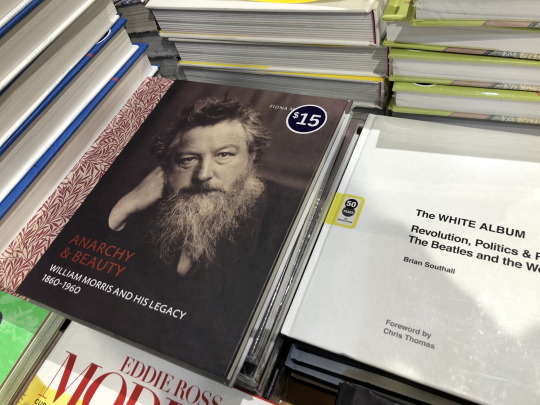
I sometimes wonder what Macklin Hancock thought of it all, as his father, Leslie Hancock, was actually a socialist politician of Tommy Douglas’s CCF party (forerunner to the NDP) who represented Wellington South in Ontario’s Legislative Assembly.
Curiously Macklin Hancock was born in China, where his father was a horticulturalist at Nanking University, but their family left amidst the Nationalist revolutionary turmoil erupting in 1927. I presume this exodus was precipitated during the ‘Nanking incident’ in March, where both Nationalists and Communists raided foreign consulates – seizing millions of dollars worth of British concessions. At that time the Kuomintang (KMT) government was backed by the Soviet Union, and led by Chiang Kai-shek, who blamed the incident on instigation by the Communist Party of China and Soviet advisors. I believe this event was somewhat of a turning point where the KMT broke their alliance with the Communists and dismissed Soviet advisors. Many communists were arrested and executed in what has become known as the Shanghai Massacre. By July of 1927, Mikhail Borodin, the once Soviet advisor to Sun Yat-sen, was ordered out of the country, accompanied by Soong Ching-ling (Sun Yat-sen’s widow) on the train ride out of Wuhan. Macklin Hancock’s father-in-law William Macklin (whom Hancock was named after) was also in China at the time with Leslie Hancock and left around the same time. Macklin had established a hospital in Nanjing, and was known to the locals there as Ma Lin. He even counted the revolutionary Sun Yat-sen among friends according to a Globe & Mail article by Tenille Bonoguore.
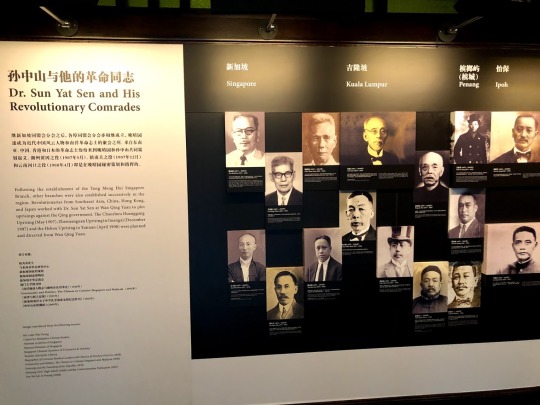
An exhibit display of Sun Yat Sen’s revolutionary comrades throughout British Malaya, at the Sun Yat Sen Nanyang Memorial Hall in Singapore. Tan Kah Kee can be seen in the top left, a supporter of the revolutionary overthrow of the Qing government as well as a supporter of the communists in China, which got him expelled from Singapore by the British colonial government. He remained in China serving in various positions in the Chinese Communist Party.
One of the great though vastly underappreciated ‘new town’ planners of the left – Macklin Hancock’s Harvard professor William Holford – shortly after these revolutionary events in China, took a trip to the Soviet Union. The Chinese architect Chen Zhanxiang’s memories of Holford are recounted in a book by Jun Wang called “Beijing Record: A Physical and Political History of Planning Modern Beijing”:
“Holford visited the Soviet Union in the 1930s and back home, he published a book entitled God’s Plan, describing the socialist country as a “planners’ paradise.” Chen Zhanxiang never read that book but heard about it from his teacher on many occasions. For him, the most unforgettable thing about the Soviet Union was that under socialism, the state ownership of land and the overriding power of the state ensured implementation of all plans. For this reason, Chen Zhanxiang, like many other students, had good opinions of socialism.”
I would love to read this book, but have been completely unsuccessful in tracking it down. What an incredible name for a book on Soviet planning, haha: God’s Plan. These religious allusions are part of what makes me so fascinated by Holford. There’s a fascinating thing he wrote about his experience in the Soviet Union that alludes to these Edenic utopian resonances that I think colour Holford’s own planning work. Gordon E. Cherry and Leith Penny in their book on Holford write:
“The appeal of the Soviet Union, however, was of a different order. For Holford, as for so many of his generation, a romantic notion of Soviet society provided a focus for a whole range of personal and social idealisms, a new Jerusalem in which it could be supposed the individual was liberated from the constraining hypocracies and injustices of life in England.”
They then quote something Holford wrote about the anxious excitement he felt about the Soviet Union, though totally conscious of the fact it could all end as a total and disturbing failure:
“It seems to me now that there could be illusions which one ought not only to let alone, but even to defend against disillusionment. We go merrily pricking the bubbles in the course of what we call education. Things and people I believed in years ago I only have sympathy for now-which is a poor thing. There remain the big illusions–love, friends, work, the big ideal of the socialist state. They go further than I can see, and because they are bigger than myself, there is something in me that makes me follow. But my ever-curious intelligence soon uncovers a danger, like a hole in a tooth. If I go on probing for proofs and experiences will I end up by pricking another bubble? Will it be the old myth of the Garden of Eden over again? I don’t know. The old serpent intellect replies, ‘you will never know unless you find out for yourself. And the outcome of it all is that I refuse to try and answer riddles, and so I say ‘Let it all come! I’ll hang on to what I have until I can’t hang on any longer’.”
And then maybe the most fascinating remark I’ve found of his on communism in general is his excitement at reading Lenin but his hilarious exercise in self-criticism – some old Christian self-flagellation – regarding his unworthiness to consider himself a worker, but rather a bourgeois intellectual. This is a letter Holford wrote to Gordon Stephenson in 1933 (Stephenson being another architect in the habit of mingling with English socialists and communists, and who would also visit the Soviet Union, twice):
“I get all worked up reading Lenin, or about Lenin or publications by the friends of the Soviet, URSS publications etc., kidding myself I’m a WORKER. Conversely, when I read ultra capitalist stuff, newspapers that make me vomit, platitudes of Dictators, or luxury nonsense, then I want to bust things up, start a clean fresh order of life, do something. The thing that worries me is that it is all in the head—not in the bones. I was bred as bourgeois as anybody and when my head and my sympathies move very far along the communistic line I become nothing more than a ‘bourgeois intellectual’. And that may mean a lot or it may mean nothing. The change to a real live communist cannot come about only through the head, and there people like Bernard Shaw utterly fail. I don’t mean he isn’t useful. He gingers people up, particularly the jolly old bourgeoisie, but his great mission never gets beyond the itching powder stage. He is Britain’s Great Irritant—useful but uninspiring.
...Conviction! that’s all it is. The old Christians used to pray for conviction, and now I suppose the only thing to do is to work for it. Just occasionally I feel holes in the armour.”
I think Holford’s dig at Shaw is hilarious, although curiously Lenin was rather sympathetic to Shaw calling him “a good man fallen among Fabians.” Gorky said he was “one of the bravest thinkers of Europe”. There’s a fairly fascinating letter Lenin wrote Gorky on December of 1921 after the Russian Civil War while the country was descending into famine:
“I am very sorry to write in haste. I am terribly tired. I’ve got insomnia. I am going away for treatment. I have been requested to write to you: would you write to Bernard Shaw asking him to go to America, and to Wells who is said to be in America now, to get them both to help us in collecting aid to the starving? It would be a good thing if you wrote them. The starving will then get a bit more. The famine is very bad. Make sure to have a good rest and better treatment.”
Lenin would end up begging the wealthier Western countries for aid, asking for “bread and medicine”, in light of the crop failure, and ended up negotiating with President Hoover, who sent aid asking they depart with some of their gold holdings to defray the costs. Some estimates have the famine’s death toll at 1-2 million. A Soviet estimate was at 5 million. Gorky ended up writing to H. G. Wells, the other Fabian they were in contact with, who quoted parts of Gorky’s letter in an article.
Shaw was actually very sympathetic to the Soviet Union, and in 1931, years after Lenin’s death had this to say about him:
“We should not think that the importance of Lenin is a matter of the past, because Lenin died. We should think of the future, of the importance of Lenin for the future, and his importance for the future is such that, should the experiment Lenin undertook — the experiment of socialism — fail, then modern civilization will perish, like many civilizations have already perished in the past.”
Shaw remained an ardent supporter of the Soviet Union for the rest of his life, even having a framed portrait of Stalin displayed on his mantel. This was not uncommon for socialists of the time though. Even Frida Kahlo, secret lover of Trotsky, had Stalin’s portrait pinned to her headboard above her bed, among other revolutionaries including Mao.
As for Shaw, his sympathies extended in other weird and disturbing directions, expressing disturbingly affirmative comments towards Hitler and Mussolini. It really does make you worry about the ‘fascist creep’ of red-brown alliances sometimes. Shaw was also a eugenicist, though this was common among socialists of his sort at the time. Even Tommy Douglas was a eugenicist, and certainly Lee Kuan Yew’s Fabian years were also formative to the eugenicist impulses that coloured his views for the rest of his life, long after he had abandoned a commitment to socialism.
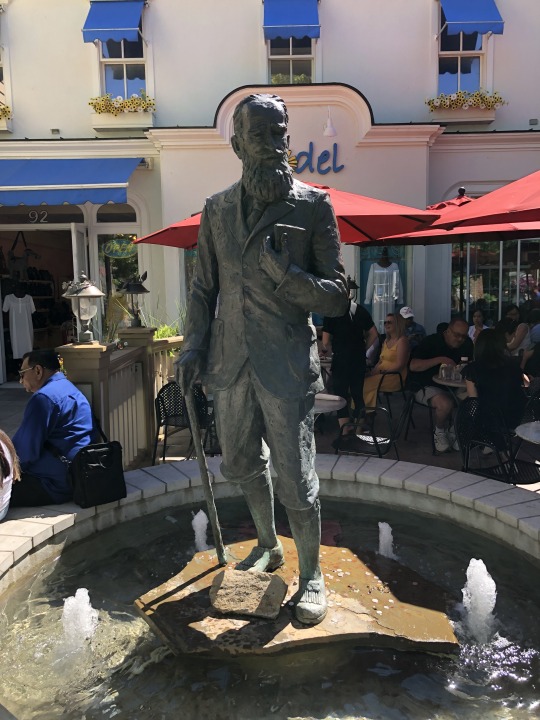
A statue of Shaw at Niagara-on-the-Lake (home of the Shaw Festival).
As for Shaw’s relationship to ‘garden cities’, he regularly gave talks at places like Letchworth, as he was in the same Fabian orbit as Unwin and Howard. In fact Shaw was one of Ebenezer Howard’s investors calling him:
“... one of those heroic simpletons who do big things whilst our prominent worldings are explaining why they are Utopian and impossible. And of course it is they who will make money out of his work.”
But what of this legacy of Letchworth. What utopia did it birth or whom did it make a lot of money for? Owen Hatherley sees Letchworth as not particularly radical, especially in what it turned out to be:
“In all of these, you can get the sense that the hope and the reality never quite met, as Letchworth became just another affluent Hertfordshire commuter town. As the planner and writer Adrian Jones puts it, "Letchworth is a comfortable place in an increasingly uncomfortable country, and that is why people like it". That isn't to be sniffed at, but it would have disappointed the radicals of the 1910s…
With little state support, the original garden city became reliant on an uneasy mix of private finance and local enthusiasm; the main employer in a town where women who didn't want to wear corsets could feel comfortable became the Spirella Corset Factory.
The British government likes to talk about building new garden cities, but never about building new new towns, which are still associated with unfashionable concepts like modernity, public ownership, and equality. It's this, rather than a love for alternative lifestyles or Arts and Crafts architecture, that has inflated the reputation of the garden cities.
At the railway station is an advertisement for Le Jardin, Luxury Retirement Living, a "stunning collection" of one- and two-bedroom retirement apartments. Its architecture is a debased version of Parker and Unwin's asymmetrical, pitched-roof style, with none of the space or grace. That's where utopia ends, here.”
Yet is there anything radical to reclaim from the surprisingly radical roots of many of these ‘new towns’ and ‘garden cities’? The suburbs are often scoffed at, yet what radical potentials lie in their midst? Hatherley doesn’t believe these ‘new towns’ are anything to scorn, and in a London Review of Books piece, defends them from the types of attacks Jane Jacobs once subjected them to throughout her career:
“There’s a problem, too, with the way her scorn for new towns and suburbs extended to those who chose to live in them. It seemed to baffle her that anyone could ever choose Levittown over the West Village, or Harlow over Stepney. Ebenezer Howard’s Garden Cities – which would become official policy in Britain, with the building of new towns after the Second World War – were ‘really very nice ... if you were docile and had no plans of your own’. This is nothing but a reflex on her part. Raphael Samuel recalls in The Lost World of British Communism that Wythenshawe, an interwar council suburb in Manchester, a project and a Radiant Garden City Beautiful if ever there were one, was a prime recruiting ground for radical politics, because it was inhabited by workers who had the self-sacrifice and drive to move out of the slums, even if it meant paying more rent. The postwar new towns attracted people who had plans; they wanted to get out of what they considered hopeless, dead-end places and bring up their children somewhere fresh and modern. Many early suburbs and new towns weren’t places for the passive, for ‘children’, yet this is just how Jacobs saw them.”
Raymond Unwin was involved with the development of Wythenshawe, and it became a hotbed of radical politics as Hatherley points out. I think about Meadowvale and what, if any, radical potential lies within its network of pedestrian pathways and the library and community centre at the heart of its town centre, and if there is any future possibility of a more socialized model of housing. There are new plans beginning to be proposed for Meadowvale’s renewal, and I think one of the most important abandoned ideas from the “garden city” and ��new town” movements was some type of mechanism for collective ownership.

Lake Aquitaine a ‘constructed reservoir’ designed by Macklin Hancock.
We have public spaces like Lake Aquitaine, some green-belted areas, greened pedestrian networks, the community centre, and library – but the increasing unaffordability of housing is the elephant in the room.

I’ve often attended a book club at Eden United Church, which sits directly across the road from Meadowvale Town Centre. One of the members also serves at the food bank that’s operated out of the church building, and she describes this gentleman she knows, an immigrant who has spent the past three or so years of his life sleeping on a couch, sharing a small space with a few other people. The large majority of his income, often unstable, goes to rent – sometimes, after paying rent and other basic necessities (but mostly rent), he has as little as $10 to stretch out for the entire month to support himself, and comes to the food bank to be able to make ends meet. He finally was able to secure a subsidized unit and came to tell her because he was so incredibly happy. She mentioned to us that listening to his story broke her heart and she wanted to cry, because there are people in immense desperation. Another person I met, who often attends the church is disabled, surviving on ODSP, and mentions that there are very long wait-lists for subsidized housing units in the Meadowvale area, and has been trying to get politicians in the area to do something about it. I think it is time we start revisiting some of the collectivized mechanisms of the early ‘garden city’ plans, whether it be old Georgist mechanisms, or new proposals put forward by people like Hatherley, who often emphasizes this aspect of ‘garden cities’:
“A key concept of the original garden cities was collective ownership, with them owned and managed by some sort of community trust for the benefit of residents, rather than in the hands – and for the benefit of – developers such as Persimmon and Barratt. This was mostly honoured in the breach in the first generation such as Letchworth or Welwyn. But today, a garden city could be run as a Community Land Trust, a form of ownership that contains clauses against speculation, stopping cities becoming middle-class commuter towns and ensuring their original intention – places without hierarchies, slums, “luxury living” colonies or class distinctions.
However, co-operative or community ownership is usually elective, favouring enthusiasts and those with time on their hands. The new city should aim for the universality that council housing once provided, through a system of housing allocation that would make housing accessible to anyone that wants it. The best model for this is still renting through the local authority.”
Holly Firmin in the New Socialist puts forward some interesting ideas for new new towns that I think would be worth considering for Meadowvale’s renewal:
“New New Towns would also provide the opportunity to enact emerging ideas around community wealth building. What better way to develop strong anchor institutions and create a locally rooted economy, based on new forms of worker ownership, than to design a New Town on these principles from the ground-up? Rather than exploiting the workers that build New Towns, they could instead belong to unionised, local co-operative construction companies. Original New Towns were themselves committed to a kind of proto-community wealth building policy of ‘self-containment’, which encouraged residents to work, rest and play within the boundary of the town.”
Can you imagine if Meadowvale’s renewal project provided jobs to local residents for maintenance, repair, and new building projects, and secured housing for everyone who needed it? Current plans for Mississauga are trying to reach a target 35% of units as ‘affordable’ housing (I guess they want the majority of its housing then to be unaffordable), but they intend these units to be acquired by way of market rental or ‘affordable’ ownership schemes. Under these schemes housing remains a commodity, subject to the market, which even Clarence Stein (not a socialist) believed should not be so.
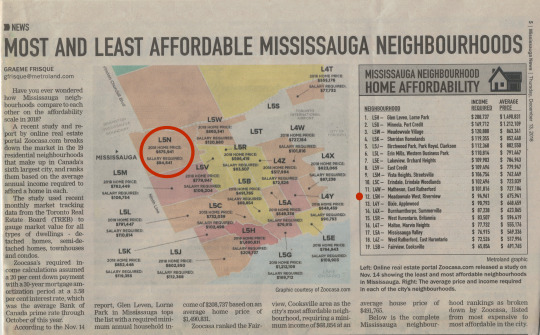
2018 list of Mississauga neighbourhoods by affordability, Meadowvale Village listed at third highest cost, Meadowvale (new town) at twelfth (out of nineteen)
Hatherley provides some interesting examples in Seoul that focus rather on de-commodification and ‘regeneration without gentrification’, and I think these need to be options kept on the table:
“A more radical model still is in schemes that both renovate and de-commodify. Recent examples include the renovation of the Seewon Sangga development in Seoul, which in its mix of housing, industry, markets and self-proclaimed ‘regeneration without gentrification’’, presents a model of redevelopment far more intelligent than anything we have dared in the UK. Similarly unusual is the renovation of the Tour Bois-le-Prêtre in Paris by the architects Lacaton and Vassal, which took a 1960s tower, slated to be demolished, and renovated it for the existing residents, giving them new winter gardens and adding wings of new social housing to the existing structure with no evictions and no changes in ownership. Notably, both of these were proven to be far cheaper than demolition and building anew, and neither has been precious about making major changes to the existing building fabric.”
I get a little nervous reading about re-development and renewal plans for Meadowvale. How much will focus on making the neighbourhood more inclusive, and how much will result in it displacing the vibrant immigrant and working-class communities that have made Meadowvale what it is today. I’m able to chat with public transit bus drivers and artists at my neighbourhood church, but the strain of housing is hard on many people. It is sad that one of the only non-profit housing options available in Meadowvale is an elderly residence that was built and operated by the United Church. We cannot rely on the private charity and generosity to make housing affordable for everyone. It has to be central and systemic to the entire fabric of our neighbourhood.
I think about Gordon Stephenson, whom Holford often wrote letters to. Stephenson was considered a man of the left in many ways like Holford. He designed Stevenage, the first of Labour’s post-war British ‘new towns’ – located between Letchworth Garden City to the north and Welwyn Garden City to the south. The pedestrian spaces and design were referred to as “Festival Style”, and Clarence Stein was consulted, with many parts of Radburn becoming features in Stevenage. Monica Felton, feminist, town planner, peace activist and Labour Party member was chair of the Stevenage Development Corporation in 1949 but was dismissed from her job, unofficially because of her status as a fellow traveller, going on Soviet-organized trips to North Korea and participating in Soviet propaganda broadcasts – even winning the Stalin Prize in 1952.
Concerning questions of the ‘renewal’ of Meadowvale, Macklin Hancock’s ‘new town’: the question will always persist: whose utopia are we creating, uncreating, recreating when we engage in these processes of ‘renewal’? Stephenson, though considered a progressive, was also responsible for his 1957 plan to redevelop the entire downtown core of Halifax, which involved the forceful eviction of Africville (which he described as a “little-frequented part of the City… an encampment, or a shack town”). This ultimately led to the forced removal of a poor but vibrant Black community in Nova Scotia.
The story of Africville has its origins in the Underground Railroad. Some slave escapees settled in the area around the 1830s or 1840s – though the Black community in Nova Scotia existed since at least the 18th century, particularly after the American Revolution, when Black ‘Loyalists’ came to settle around Halifax. (As J. Sakai explains in Settlers, liberating slaves for participating in imperial military operations is hardly liberatory, both on the side of the British and the United States, and consequently the same oppressive structures from slavery will persist since they have not been properly addressed through real liberation.) Africville were a largely self-sufficient community, though one that had to resist perpetual attempts of removal and environmental racism.
Since the Halifax explosion of December 1917, when four residents of Africville died, the city had been trying to find a way to rid itself of the settlement. 1917 was the same year Trotsky was detained at the Halifax harbor on British MI5 intelligence. In March of 1917, Trotsky was making his way from New York back to Russia to join the revolution that was breaking out there. On April 3, he was detained by British officers and sent to the Amherst concentration camp, all of which he described in in a chapter of his book “My Life”.
By April 29th, Trotsky was told to pack his bags and he and his family were released – but not without stirring up some trouble in the concentration camp during his stay, where he spent time organizing the prisoners, setting up translation teams, political discussion groups, and proselytizing on behalf of the revolution. Captain F. C. Whiteman, second-in-command at the camp commented that if Trotsky had stayed in the camp any longer, he’d have turned all the German prisoners into communists. By the time of the Halifax explosion on December 6, Trotsky was already back in Russia, the Winter Palace had been seized by the Bolsheviks, and a Constituent Assembly had been elected – only to be closed down by Lenin in January.
Back in Halifax, the targeting of Africville was intensified by the city. Despite paying taxes, Africville did not receive most services from the city – no sewage or water, no roads, no health services, no electricity. A open-pit dump site was built in Africville in the 1950s, leading up to its classification as a ‘slum’ and its ultimate demise.
Stephenson had accepted a position at the University of Toronto in 1955, after initially planning to accept a position at MIT, but being denied permanent residency in the US. While in Toronto he worked on an ‘urban renewal’ project for Regent Park, while also helping with the design of the Kingston waterfront and the Eaton’s Centre. While Stephenson saw the poor conditions of Africville and said that it “stands as an indictment of society and not of its inhabitants”, many of the justifications for the ‘slum clearance’ efforts and forced relocation at Africville involved business interests, such that commercial development could expand into the area. Despite Stephenson’s socialist leanings, his most remembered legacy in Canada was the razing of Africville – roundly condemned now not only by all manner leftist political parties throughout Turtle Island, but even by liberals. This is the way Stephenson described Africville in his 1957 Halifax redevelopment report:
“There is a little frequented part of the City, overlooking Bedford Basin, which presents an unusual problem for any community to face. In what may be described as an encampment, or shack town, there live about seventy negro families. They are descendants of early settlers, and it is probable that Africville originated with a few shacks well over a century ago. Title to some of the land will be difficult to ascertain. Some of the hutted homes are on railway land, some on City land, some on private land. There will be families with squatters rights, and others with clear title to land which is now appreciating considerably in value. The Citizens of Africville live a life apart. On a sunny, summer day, the small children roam at will in a spacious area and swim in what amounts to their private lagoon. In winter, life is far from idyllic. In terms of the physical condition of buildings and sanitation, the story is deplorable. Shallow wells and cesspools, in close proximity, are scattered about the slopes between the shacks. There are no accurate records of conditions in Africville. There are only two things to be said. The families will have to be rehoused in the near future. The land which they now occupy will be required for the further development of the City. A solution which is satisfactory, socially as well as economically, will be difficult to achieve. Africville stands as an indictment of society and not of its inhabitants. They are old Canadians who have never had the opportunities enjoyed by their more fortunate fellows.”
While Stephenson’s plan was framed as a progressive way to provide public housing to improve the material livelihoods of the residents of Africville, it was more fundamentally about clearing the land to make it more attractive to capital. Stephenson commented that after clearance, “It may now redevelop the land for highest potential its use.” And while his plan was initially accepted as a viable liberal welfare reform, radical Black activism in Halifax began raising more awareness about the actual nature of the relocation process. Visits to Halifax by the Black Panthers and Kwame Ture (born Stokely Carmichael) helped establish a Black Panther Halifax chapter in 1969 and the Black United Front, lead by organizers such as Rocky Jones, Joan Jones, and Yvonne Atwell. The displacement of Africville, and the role of capitalist investors as well as ongoing racism came into clearer view and the true nature of Halifax’s ‘urban renewal’ process came into larger provincial and national discourses on racism.
However, these visits by radical Black Power activists put the local Black community on the radar of the RCMP who conducted surveillance projects on them for years to come. Rocky Jones would be tracked by the RCMP for over a decade. Jenifer Nelson’s book “Razing Africville” details some of the measures the RCMP took including tapping phones, intercepting mail, stakeouts outside homes, undercover incursions and informant operations into Black community meetings and nightclubs.
This is part of Stephenson’s legacy in Canada. While it is useful to see the radical roots of certain ‘garden city’ principles had on the ‘new town’ movement, advocated by progressives like Stephenson and Holford, and their eventual affect in Macklin Hancock’s Meadowvale, it is maybe more important to look to radical racialized groups like the Black United Front in Halifax to more closely examine the real effects these ‘new town’ planners had in practice. Whose utopia were they creating? Whose utopia were they renewing under racial capitalism?
William Holford called Hancock’s Don Mills ‘new town’ “probably the most attractive natural town site that I have ever seen.” High praise from a very distinguished planner of the left, yet for whom was Don Mills attractive under the ‘free-enterprise’ economy Hancock always made accommodation for. Whose freedom was prioritized in this ‘free market’? Attractive to capital or to ordinary working people? And now decades later, with GTA house prices unimaginably high, who can afford to be attracted to a place with scanty non-profit offerings.
Macklin Hancock grew up many of his years on his family plot in Cooksville, Mississauga, where he lived next to the nursery run by his father Leslie Hancock. The nursery was said to have hired a number of Japanese Canadians during WW2, so as to help them avoid the internment camps setup by the Canadian government. This plot is also very close to the home Duchess Olga lived in at the end of her life – she was a Romanov, youngest child of the Czar Alexander III, who fled the Russian Revolution of 1917.

The Hancock plot of land has recently been acquired by the City of Mississauga as parkland, and the woodlot on this plot has some of the oldest white pine trees in the area. Much of Mississauga used to be covered in these tall white pines, before they were processed in 19th century sawmills on the Credit River, like those around Meadowvale Village, and sold to the Royal British Navy for their imperial projects abroad and to construct roads that would become the backbone of Canadian settler capitalism. The attendant deforestation and destruction of the Credit River and its salmon populations would displace the Anishinaabe. Meadowvale ‘new town’ was in many ways named after this ‘bucolic’ old utopian village on the Credit River, a good distance east of what would become the New Town’s core. These nostalgic allusions to some utopia of White settlers was at the same time an indirect allusion to the destruction of indigenous communities who had treasured and lived off this land for centuries. This is the complicated history that Meadowvale will have to come to terms with as it looks for new ways forward.
0 notes
Text
Response: The 2nd
I again ask of my viewers and followers NOT to attempt to seek this person out or cause them any inconvenience. This is my thing to tackle and had they not blocked me, I would be able to respond within the confines, but I felt it was neccesary to allow this debate to be in the public forum.
It's funny how you still try to worm your way out of having to accept that maybe, just maybe, you fucked up. Democrats aren't even fucking leftists, and never were; historically they were the more conservative party all around, over the course of the 1930s to the 1960s the parties' relative positions switched around, today they're liberals. Every other country in the world considers liberalism a right-wing ideology, at best a centrist one for a reason (hint: it has something to do with being vehemently pro-capitalist)
Incorrect. That is a pernicious and commonly held myth that does not hold up to scrutiny.
<div class="tumblr-post" data-href="https://embed.tumblr.com/embed/post/ZxD-qUmiewEE0H0tTone4Q/163463839262" data-did="da39a3ee5e6b4b0d3255bfef95601890afd80709"><a href="http://zucca101.tumblr.com/post/163463839262/the-political-parties-in-the-1860s-are-not-the">http://zucca101.tumblr.com/post/163463839262/the-political-parties-in-the-1860s-are-not-the</a></div> <script async src="https://assets.tumblr.com/post.js"></script>
Also, Sargon, left of center? Reads-the-headlines-and-nothing-else-of-the-articles-he-cites Sargon? Constantly complains about The Left™ like you do and constantly apes the same rhetoric coming from the far right Sargon? That Sargon? Yeah, no.
He is on the Left. He’s become disenfranchised with the Social Justice angle it’s adopted and the Islamophilia as well. And God only knows, there’s enough I disagree with him on to fill a book, but someone who actively challenged him and pored over his vids, found one thing Sargon got incorrect, and it was something he had already retracted.
I don’t agree with him on everything. But I trust him due to his intellectual integrity. Same with Teal Deer, same with the others I watch.
"And I CHALLENGE YOU to show me where I said that women should not have access to healthcare. Or even hinted at it." That's not even what I said, and you damn well know it. My implication was that you're in favor of restricting healthcare access to the poor, which guess what, if you're going to be in favor of repealing shit that makes healthcare more accessible to them, basic logic would dictate that's going to happen. You manage to go off on an entire tirade about abortion when what I was addressing was the supposed line of thought behind it.
Fair to say, but that’s not what I’m in favor of either. The Affordable Healthcare Act was like a shiny used car sold by a constantly smiling, charming salesman. It ran fine for the first stretch, but broke down after you got around the bend. Libertarian that I am, I believe such an act was foolish because it was nothing more than a scam by the insurance companies lining up to get all the business they could ever ask for because signing up for healthcare became COMPULSORY. Which is bullshit.
Also? I hate to be the one to give you the newsflash, but jobs aren't going to save society. We already work far more than we need to to keep things going, or even to afford a high living standard - most jobs that currently exist do because either it's marginally cheaper to severely underpay people for them rather than to automatize them, or otherwise only exist as an artifact of capitalism itself - many different corporations that require management, marketing that simply wouldn't exist under literally any other economic system.
I’d love to see citation for that which doesn’t reek of Socialist claptrap. Automation is progressing, to be sure, but progress is progress, right? That doesn’t mean there isn’t work to be had if you either look for it or try to find it outside of your comfort zones. I had to work at a Wal-Mart of all places, but I swallowed my pride and I did it. Didn’t enjoy it, but I did my job.
Between this and the ongoing trend towards atuomatization? Those jobs are going to disappear, and there aren't going to be new ones in sufficient numbers to avoid giant swathes of people in permanent unemployment. That's not me doomspeaking, that's a logical consequence of what's going on today.
It tickles me something fierce that you don’t actually address the automation. You think SOCIALISM would fix that? By making things so shitty that automation isn’t an option, perhaps. No, Socialism would cram everyone into a job and regardless of whether they want it or not, they MUST do that job.
By the way, speaking from years of first hand and second hand experience here: unemployed people don't actually sit on their asses all day, contrary to what you've been led to believe by people who have a vested interest in keeping everyone working for scraps.
Speaking from second hand experience myself, I’ve had friends and friends of friends who NEVER got real jobs and instead collected food stamps they bartered for room and board. I’ve known people who have chosen to panhandle and beg on the street rather than go to a job. (And to be fair, that’s non-taxable income…) So I’m afraid anecdotal evidence from either of us is not enough to conclusively prove this one.
Therefor…
http://www.epi.org/publication/missing-workers/
http://www.pewresearch.org/fact-tank/2017/03/07/employment-vs-unemployment-different-stories-from-the-jobs-numbers/
Jobs aren't the only way to contribute to society, most artists do work that can't support itself under capitalism (and that logically the artist themselves wouldn't be able to keep themselves fed on without at the very least some sort of social safety net), and if we only kept going with that art that proves to be profitable enough to support someone, thereby only appealing to the lowest common denominator?
And…. And you think COMMUNISM or SOCIALISM will let you art the way you want to? At least in Capitalism, an artist can make money for their work! Hell, the internet and Patreon has made it easier than ever for someone to make a living with their art or at least supplement their living. I know HUNDREDS of artists who balance art for its own sake, art for income and a normal job. And they’re not unique in that sense. Art enriches a culture, absolutely, but when it’s dependent on the government… then why would one go BACK to a normal job if they can make a period blood painting, throw it on the wall and demand money from the government? Art should be independent of governmental meddling.
And if you ask Joe Average if he would rather be COMPELLED by the government to pay forty bucks every month to contribute to art or fill his car’s gas tank, buy a few bags of groceries for his family or get used shoes at the Thrift Store, what do you think he’d do?
Art flourishes when free of meddling.
You’re an artist, yes? Suppose you got a check from the government for creating art… but suppose your art did not hold up to some arbitrary definition? It’s taxpayer money after all. So you would have to create art… but only as the government sees fit. Which is no different than making art by commission… except for the fact that under capitalism, you can create art as work, you can create art after working hours, you can create art just to make someone smile. You aren’t beholden.
I can tell you right away this world would be an immensely darker place for it, and all that precious inflation art would vanish overnight.
Heh, the one I had in mind at the top of my list when mentioning those hundreds of artists is a very prominent one. He works a daily job, he makes money with his art, and he makes art for its own sake.
Take a look at this picture…
https://zucca-xerfantes.deviantart.com/art/Berlin-Wall-piece-from-Reagan-Library-612126840
Riddle me this…
The side you see if colorful and full of art and vibrant colors and the other side is matte gray, untouched.
Take a WILD guess which side was the Commies’…
In addition to that, it's beyond unethical to force people who can't work to beg for scraps from charities that both A) impose their will on them (like the Salvation Army), and B) even if all perfectly good natured, wouldn't collectively have the resources to support everyone anyway, especially not when it's entirely within the state's means to give those people a decent standard of living.
Uh, I think I already said that I’m not against government assistance for those who are literally unable to work.
As for your examples, the Salvation Army’s policy is NOT to deny service to trans or homosexual people. A same sex couple can be permitted, but as separate individuals. I don’t hold to that part, but hey, their house, their rules, and they’re not turning them away outright. Now while it’s true that SOME SA people refuse service, that is not the organization’s policy. And considering they saved the life of an IRL trans friend of mine, I am STRONGLY disinclined to believe smear stories.
As for the second, See first paragraph in this section.
"Constantly pretend to…. universally bad…? WHAT….?" You know damn well what I was talking about. The constant "oh, Muslims throw gay people off of buildings all the time! You should be thankful!" takes? The kind of bullshit that you spout to propagate hate against them in the name of "protecting us" when you subsequently turn around and support people like Mike Pence who wishes we'd all vanish, one way or another? I see you, and your cutesy "but I have black friends" argument doesn't fucking work here.
If you can prove me wrong about how Islam as a whole feels about homosexual people and transsexual people, then I will apologize right now. Imams view the murder of homosexuals as A MERCY for fuck’s sake. That is some kind of bona fide evil. Yet for some reason, your fluffy Social Justice Totem Pole places a Death Cult’s feelings above YOUR RIGHT TO *LIVE* SO JUST EXCUSE THE SHIT OUT OF ME FOR CALLING IT OUT.
And supporting Mike Pence….??? I couldn’t give less of a crap about him if I tried. The dude is an advocate of conversion therapy, which does not work. Case closed. Frankly I think Trump picked him for the same reason Obama picked Biden. Assassination prevention! ‘You might kill me, but SERIOUSLY, look at THIS guy… you want HIM instead?’
Jokes aside, I don’t agree with Pence. If, God forbid, he became president, I’d support the office but if he started making life harder for the gay people for no reason, then I’d be fundamentally opposed.
Again, you know this, but damned if you’ll permit that to get in the way of a good strawman whoopin’, eh?
And I find it ASTONISHING that you lie to yourself that Pence is the one to be feared when there is nothing he can legally do to hurt you, but the Death Cult wants you to actually die and are SANCTIONED in such acts.
Pulse Nightclub ring a bell? Fifty innocent people murdered by a guy whose religion told him that his only salvation for his sins was to become a martyr.
By the way, you also don't get to decide who's actually trans and who isn't. Trans people detransition or don't bother transitioning for any number of reasons. Doesn't mean the person underneath isn't transgender, most of the time it's just because society is so fucking harsh against us that they decide living in the wrong body and being seen the wrong way by others is less painful than the outright hostility we can expect on a daily basis.
I’m speaking real here… I cannot possibly understand what it’s like to be Trans. I cannot appreciate the struggles that a trans person is forced to go through. A friend of mine lost her wife and her children because she transitioned. And she’s one of the most gentle and decent souls I’ve ever known.
But she is a real Transsexual. Not some idiot child enamored by the idea of being Transsexual. Not some teen who wants to piss off their parents, or some snowflake who wants to be that much more special. What they do is an INSULT to the Trans people who struggle with it. Who, as you have pointed out, have a ton of shit they have to put up with without their struggles being trivialized..
I’m not of the notion that Trans people have it easy because PC culture has elevated them above others (Except for the fanatical Death Cult that wants to kill them) or anything like that.
I disagree with that notion which is held by a large number of YouTube personalities I watch regularly.
However… in the same way I have nothing but contempt for idiotic children and childish adults who pretend to have Multiple Personality Disorder because they think it’s some kind of fun game where The Doctor and Loki play around in their head, I can’t stand the same kind of idiot children who think they can switch their gender like a toggle and to be SUPER SPECIAL AWESOME have a fantasy word to describe their nonexistent gender.
But oh no, I’M the scientific illiterate. >_>
As for "you don't have the right not to fuck a trans person" (lol), literally nobody is actually saying that - those takes are about dismissing the idea of having sex with someone who's trans out of hand, not saying no if the opportunity were to actually come up.
…
Honest question, you haven’t heard of Riley Dennis, have you? Very prominent Trans YouTuber who has numerous videos now shaming straight people for not wanting to get into a sexual relationship with a trans person.
Riley is of the mind that straight people don’t have a right to refuse, lest they be bigots. >_>
And if you think that’s an absurd thing to say, then bless you. We’re in agreement.
And if it were just Riley, that’d be one thing, but here on Tumblr and on Twitter, there are posts saying much the same, but not in the weasely, round-about way Riley did.
Do I think that’s the majority opinion? No.
But it is not a case of ‘Literally no on believes that’.
And if Christians have to be lumped in with wretches like the KKK and Westboro, well then... what’s good for the goose ought to suffice for the gander, hm?
As for where you're anti-science? Ho boy, where do I begin. Those hot anti-climate change takes of yours are a good start, dismissing everything that happens in that regard as "just the weather" when sea level rise, melting ice in the polar areas as a result of it, and year after year of hottest yearly average temperatures have not only been happening for at least the past century, but have also been accelerating more recently. I'd know, I literally live in one of the places directly affected by this. Most of this country is below sea level, we keep having to build up our dams and dunes even higher to avoid flooding the damn place like what happened back in 1953. To dismiss all that as "the weather" is beyond foolish.
I never said Climate Change isn’t real.
Nor have those I’ve reblogged.
The notion of manmade Global Warming is what is contested.
See, there was a smart way to go about spreading the message and a stupid way to go about it.
The stupid way was to let hypocritical hacks like Al Gore dominate the stage.
The smart way would’ve been to appeal to everyone’s common need to save money and how many green tech save water, electricity and gas bills.
But nope…. Shaming was WAY more fun and satisfying. And now it’s become politicized.
I’m a wildlife conservationist of a sensible variety. Sharks, whales, rhinos and cheetahs are being driven over a cliff and it needs to stop.
And there are more than a few Conservatives on the same boat. Michael Savage, radio host, for instance.
But stereotyping and shaming is SO MUCH MORE SATISFYING TO THE BASE URGE OF APPEASING ONE’S INNER RIGHTEOUS INDIGNATION.
ISN’T IT?
"Capitalism gives everyone the same shot at living" is an even more ridiculous take if I ever saw one. Yes, I'm sure my disabled, mixed and poor ass has the exact same chances as Reginald who can simply ask daddy for money to start up any business he likes, or hell - just live off of that, put it all in stocks, hire some people to make sure his investments don't go to waste and be set for life! He doesn't even need to work! At all! No rich person does!
Step away from the Marxist teacher, amigo. They are NOT your friend…
You’re full of shit.
I’ll out and say it right here.
You are so full of shit on this one that your eyes are turning brown.
You’re just barfing up the same politics of envy nonsense that every single frakking Socialist hack barfs up.
“I can’t work because there’s some rich guy out there who has more stuff than I do!!!! HARUMPH!!!!!!!!” Do you hear yourself...?
Does the nature of your disability preclude you from doing ANY work? If so, then that is a case wherein you should be lent aid.
But if you have your hands… you can work. If you have your legs, you can work. If you have your eyes, you can work. If you have your wits, you can work. If you can’t find work, look harder. Or make your own. That’s what I did. I was destitute only seven years ago. And I’ve built myself up. And that was all done with clinical depression weighing me down like lead.
Self-determination? Ah yes, being forced to slave away at a minimum wage job because you simply can't get hired elsewhere for the rest of your life, or starving. That's self-determination in the same sense that having the choice between following orders and maybe be allowed to live, or don't and be killed when someone holds a gun to your head is. Venezuela, or any other socialist country in the world is/has been hardly perfect, but you know what's not helping?
YOU DO NOT HAVE TO WORK AT A MINIMUM WAGE JOB FOR THE REST OF YOUR LIFE.
Sorry, sorry… you’re like the fiftieth person whose thrown that at me and it gets cringier every time I hear it… I apologize.
But seriously, if you think that min wage is for life, you’ve not made very good decisions.
You start at the bottom and work your way up. Just because you spend a few years flipping burgers doesn’t mean you’re stuck there!
Fuck… you can apprentice with a plumber and be making SIX FIGURES in FIVE YEARS!
I kid thee not!
Fascist protestors literally burning supplies that are already hard to get by. Action taken by the US to undermine pretty much any socialist country that has ever existed. As for more internal problems? Guess what, those can be improved upon. It's an economic system, not a religion.
Can be? Doubt it, but maybe.
Will be? No.
And as for being an economic system and not a religion…
That’s a mighty tall claim, considering the fact that Socialism tends to butt out religion and replace it with itself. Take China for example. All their rich culture, their ancient heritage, their majestic architecture, their thousands of years of history and artifacts…. FUCKING RUINED BY A LITTLE SHIT WITH HIS LITTLE RED BOOK.
The very basic premise you utterly fail to process here is that this shit is subject to constant rethinking and revision, something made impossible when some strongman figure decides to take power, no matter what side of the political spectrum they're on - that said, the right loves those far, far more than anyone left of center will, as a matter of basic principles that define either side.
Which is one of the fundamental flaws in Socialism and Communism. You can’t build off of that when the foundation is garbage. And how many MOUNTAINS OF CORPSES do you wish to produce before we ‘Get Socialism right’?
Thanks, but Capitalism has existed LONG before Socialism.
Otem from the Mountain People went to Trajk of the Plains People because the Plains People make masterful spears. He traded a basket, which the Mountain People make better than anyone, including the Plains People, for a spear. Both people are wealthier as a result.
And that also leads us to why I consider right-wingers universally shitty people: plainly speaking, they simply are.
And you call ME the bigot…?
It's at best ignorant, at worst astonishingly hypocritical as can be to act like you care about the poor, only to deliberately make their lives harder using the political apparatus in place.
You know that is not the motivation of capitalists. And if that’s what you think, then you are simply incorrect.
You can't say you care about groups of people, then vote for those who are all too happy to take their rights away.
I DO care and I disagree with the ban. While I find it iffy to put people who deal with what Trans people do into severely high-stress situations, if they believe they can hack it, I believe they have a right to stand proudly beside the other defenders of the country.
Actions speak louder than words, and actions that affect an entire country weigh far more heavily than those taken on an individual basis - giving money to individual homeless people simply doesn't counterbalance supporting the people who make sure they can't sleep anywhere by putting spikes out in public places.
Spikes out? It’s the LABOR PARTY in the UK who want to fine homeless people a thousand pounds for sleeping in public.
See my above points for further rebuttal. I’m not repeating myself.
Don't bother acting like I'm saying all this out of ignorance either - I've been there myself. I've had a right-wing phase, I only need to look back at my own past actions to see the hypocrisy that lies underneath.
I’m not going to say that everyone one the Right are Saints. You know that’s not my position. I also don’t think everyone on the Left are foolish. Fuck, I don’t even think the majority of them are bad people at all! I think they’re people whose hearts are generally in the right place, but feel rather than think. But you are, inversely, able to forgive EVERY sin of the Left while, and I quote, labeling every right-winger as universally bad people.
That is some FRIGHTENING SHIT right there, amigo. That you can de-humanize EVERYONE on the opposite political spectrum because you’re so high on your own moral superiority that you’ve willfully blinded yourself.
And while ignorance itself is forgivable, you've repeatedly shown not to care in the slightest for anything that would lead you to reconsider your ideas, nor do you have any interest in actually putting your money where your mouth is on the grander scale with just about anything you mentioned in your post.
HAH… if you only knew…
So yeah. Come back to me when you've learned to genuinely care about other people beyond those in your direct personal sphere.
So you’re moving the goalposts, huh?
I contested that I’m not the evil strawman you have created and now you’re saying ‘Well, you may care about the people around you, BUT WHAT ABOUT EVERYBODY ELSE?!’
Friendo… I can’t care about everybody else. Everybody else are adults, or will be someday. Then everybody else can care about everybody else. They’re my neighbors and I genuinely wish them well. I’ll help a stranger’s reasonable request just for the asking. But I am not Atlas. I cannot take on all the problems of the world. I can voice my opinion on how they should be dealt with, to be sure. Because I have that freedom.
I care for my country and fellow citizens, and I will vote according to how I believe they can best be helped. But it is *not* my responsibility to solve all of their problems for them.
Even if I could, I would not. Because it’s our problems and our struggles that make us grow.
The butterfly cannot fly if it doesn’t struggle its way out of the cocoon. A well meaning person may peel the cocoon away, but that dooms the butterfly to a flightless life.
Buddha said that life is a struggle. And he wasn’t wrong there.
But while we can help our friends, our neighbors and even strangers, that does not mean that it’s relative across the board.
Poverty in the West is a child asking his father why he’s crying as he weeps over a stack of bills on the table. Poverty in the third world is emaciated children with rice-bloated bellies.
Both are heartbreaking, but both are unique to their places of origin and therefore are not comparable.
You can lie to yourself all day about who I am, what my motivations are and what my heart is like.
But if you found out who I am, what I’m like, how I behave, then you may be willing to face down your other prejudice against an entire group of people you have frighteningly labeled as universally evil.
1 note
·
View note
Text
Universal Credit.
“I don’t want to be here.” I remember very clearly saying that to the admin-lady who took copies of my ID almost two years ago. I didn’t say it very clearly at the time, I was crying, in the middle of a mental health crisis. I did have the presence of mind to add “Here, in the Job Centre, not ‘here’ at all, I’m not suicidal.”, which is possibly the sort of thing a suicidal person might say. Then, when I’d been verified as a human resident of the UK, with a full working life to date of National Insurance contributions, I said it again, to my new ‘Work Coach’ “I’m not suicidal, you don’t have to risk-assess me, I’m ASIST trained.” “Oh, I’ve done that course, too, horrible, isn’t it?” (Job Centre frontline staff are trained to recognise and respond to suicidal ideation or intent. ‘Let that sink in.’, as the young people say.) She didn’t risk-assess me, she did say “Oh, don’t cry, you’ll set me off!”, which was possibly her way of showing me she was a human being, or possibly a tactic to divert-minimise the obvious distress I was experiencing.
Distress which may or may not have invalidated my capacity to consent to the Claimant Commitment she had me sign. It wasn’t an informed consent, in any case “You need to sign this, or your claim will be delayed.” isn’t actually threatening, but it felt that way at the time. I tried to object to the generic pre-formatted wording on the Commitment. I have disabilities, I’m not ‘fit for’ ‘Any suitable work, paying over £7.50 per hour, up to 48 hours per week, within 90 minutes of home’, but I wasn’t ‘officially recognised’ as disabled at that point. The concession she agreed to make was to alter “I am in good health” to “I am in reasonable health.” Pat on the head for signing a commitment I didn’t agree with, 48 hours plus 90 minutes each way would place me, or others at risk of harm, I have brain injuries, I’m not lucid for a ‘full’ working day, my cognitive capacity slides away during the afternoon and evening. “Here, one of my other customers made this form you can use to log your work-search, it’s really good, he’s been to university.” (It wasn’t ‘really good’, I think she just likes pretending to be a teacher, and ticking forms, I made alterations to improve the form, controlling a tiny little thing like that helped, because I had precious little control over anything else.)
I’d signed the commitment to spend 35 hours per week actively seeking suitable employment, and I did a lot of seeking, but the majority of my additional ‘outcome’ and ‘follow-up’ columns on my modified form read ‘nothing suitable’. My second appointment was ten days after the first, and my ‘time-sheet’ logged 67 hours. Date/action/outcome/follow-up/hours, meticulous, accountable, cross-check-able, I’d registered on all the websites the Job Centre suggested, and quite a few that they didn’t seem to know about, I’m a resourceful type. I also have (more than one) ‘fluctuating’ medical conditions, so have a tendency to try to run ahead of myself ‘banking hours’ in case I have an ‘off’ day. The Work Coach panicked. “Don’t do that, you’ll make yourself ill!”, in an attempt to de-universal the Claimant Commitment, and possibly avoid more paperwork for herself, she reduced my hours-actively-seeking from 35 a week to 35 per fortnight. I’ll blow my own trumpet here, when I’m functional, I’m hyper-functional, I’m just not functional all day any more. I wasn’t just looking at the unfit-for-purpose ‘Universal Jobmatch’ website, which was full of expired vacancies, and vacancies that weren’t actually vacancies but “The position advertised has now been filled, you may be interested in this £500 training course.” scams. For every vacancy I clicked on, I linked out to the actual website of the employers, cross-checked expiry, hours, essential and desirable qualifications and skills, and ran the postcode through the public transport journey planner. I wasn’t just looking at the ‘situations vacant’ in the local papers, I was reading every single page for news articles about new initiatives I could make speculative applications to. I wasn’t sitting in my pyjamas watching Jeremy Kyle.
“You need to attend this course.” Right, OK, fine, I know where that place is, and how to get there on the bus, and it’s a morning appointment, so there’s less risk of me turning up during an episode of brain fog, I can do it. I did it, and, to my shame, I realised how different I was to the other claimants. In my postcode, Universal Credit was being introduced to ‘Single adults, no dependent children’ making new unemployment claims. “Have you all done a CV?” “You need to do a CV.” “Have you all registered on UJ?” “You need to register on UJ.” Ten new claimants, two bouncy-enthusiastic Work Coaches, who kept looking at the clock, and the door, the course was supposed to last an hour, but there was a scheduled bomb evacuation drill half way through. (The Coaches hadn’t checked if anyone would need assistance during an evacuation, or advised us that we should take all bags and belongings out with us- that’s a bit of my superiority complex leaking out, one of my old roles was writing risk assessments.) One of the men didn’t have ‘a computer’, one of the women had tried to phone ‘the helpline’ and spent so long on hold that she’d used up all of her mobile credit. “Oh, you can pop into the Job Centre to do that!” We were hopeless/dejected/terrified, nobody wants to exist in that state, and that’s what Universal Credit relies on, that the most-functional will adopt an attitude of “Sod this for a game of soldiers.”, and find work, any work, just to get out of the system. “If you find work, your UC claim will be held open for 6 months.” They know that some people will drift into insecure temporary employment, zero-hours, dubious jobs, because anything at all is better than the absolute anxiety and pervasive paranoia of UC.
The ‘waiting period’, the assumption that every new claimant will have their last month’s wage from work still to come. My contract ended in March, I’d tried finding a job myself all the way through April, and then realised that what I had left in the bank was all I had in the world, swallowed my pride, and ‘signed on’ for the first time in my life. Electronic application, phone-call with an appointment time-and-date, and the list of ID to produce, then the face-to-face at the Job Centre. If you don’t have the ‘right’ ID, your claim won’t be processed. I’ve never held a passport, and I only had the ‘short’ birth certificate, when they specify the ‘full’ one, I think I only slipped through because the admin-lady didn’t want me snot-crying all over her desk. I started the application process at the beginning of May, and wasn’t ‘paid’ until half way through July. The ‘five week’ period, if you read the forms properly, is actually seven, there’s the ID-check appointment required to activate your claim, the first week of your claim doesn’t count, and then there’s vague waffle about ‘allow an extra week for payment’. I allowed the seven weeks, and then another one, just to make sure, then I phoned the helpline. “Oh, did you claim Housing Element?” “I don’t know, I don’t know how any of this works.” (As it turns out, nobody knows how it works, because it doesn’t work.) “Right, well I can see on here that you did, and there’s a problem.” (If you can see that I did, why did you ask if I had?) I’d had to provide a copy of my tenancy agreement, I didn’t have it at the first appointment, so had brought it to the second one. My Work Coach had posted it off, someone in ‘Housing’ had noted that my ex was named on it, and put it in a drawer. Really. “I can authorise your Standard Element today, but your Housing Element will need to go to a manager, it’s a two-day task, don’t phone back before the two days are up.” “Right, OK, can you tell me how much it is?” “Your Standard Element is £317.” (A month, I used to earn that a week.) “Can you tell me how much the Housing Element is, so I know how short I’m going to be for my rent?” “No, I don’t do Housing. If it is short, you can apply for Discretionary Housing Payments, but I think you have to pay them back” (Discretionary Housing Payments, if allowed, are made by the local authority, not DWP, and you don’t have to pay them back.) Splendid. She did authorise the £317, but she didn’t forward the message to the Housing department. I phoned back after the 2 days, and a very apologetic young man confirmed that the task had been noted but not actioned. Another two days, and I spoke to a Housing manager. “Can you give me your ex’s contact details, so we can verify that you’re at separate addresses?” Hell, no. I’m not escaping DV, or in any situation where him being contacted would place me at risk of harm, some people will be, I just didn’t want the shame-factor of him knowing I was unemployed. I gave her his NI number, 20 seconds later she’d cross-referenced with HMRC, and rubber-stamped the Housing Element. (Which was £150 a month short of my actual rent.) 10 weeks, not ‘five’ or ‘six’ for the first payment, and it was only activated because I chased it, some people won’t be able to do that.
For almost a year, I kept-on-clicking, my Work Coach steadily reduced the number of hours per week I was expected to use for work search, because I was also in the process of applying for PIP disability benefit, and that’s job in itself. ‘Rolling six existing benefits into one’ looks great on paper, but there’s still fragmentation in the system. There is no ESA, ‘employment support allowance’ component in the UC system, it’s now termed ‘Limited Capacity for Work’, and, from my experience, the Job Centre just sort of cut you loose. (And wait for you to start moonlighting as a pole-dancer or something, probably.) However genuine and human the Work Coaches are, they’re not supposed to show you how to get around the system much more than is required to tick boxes. I’d told my Work Coach repeatedly that I had disabilities, and she’d seen the deterioration in my mental health over the months, I was disintegrating in front of her, which can’t have been comfortable to watch. Still, she watched, because she wasn’t allowed to ‘give’ me the get-out-of-jail card. When my PIP application was declined, I appealed as-per-protocol, through the Mandatory Reconsideration process, pointing out to the Coach that any system with a ‘mandatory’ reconsideration written into it knows that it’s flawed.
My Mandatory Reconsideration request was processed, and the PIP was still not-awarded, that’s a deliberate tactic within these policies, people who ‘could’ manage without assistance drop out of the system. I know that, because the first time I applied, after the life-altering brain haemorrhage, I thought I could manage, as it turned out, I couldn’t. The next stage of the process is a Tribunal, people with disabilities have to go to court, and justify themselves to a Judge, a Doctor, and a Lay-person specialising in disabilities. (That’s where ‘Daniel Blake’ would have ended up, if he hadn’t died.) I requested a Tribunal, and provided additional evidence, as well as completely eviscerating the cut-and-paste mess that ATOS had made of my ‘reports.’ That was difficult, not just the process of reading through 300+ pages of my evidence, and their evidence, but the continual repetition of what I can’t do any more. I had the Job Centre on one side, encouraging the ‘positive, can-do attitude’, and PIP/ATOS on the other side, asking for profoundly embarrassing details on washing/dressing/toileting difficulties. It was a waiting game, I’d applied for PIP in March 2017, I didn’t have my Tribunal until July 2018, the same week as my re-scheduled ‘Work Capability Assessment’. (They cancelled the first one with less than 24 hours notice, they hadn’t sent the ‘reminder’ text, they had no intention of holding it, these systems have made me paranoid.)
The Work Coach could have triggered the Work Capability Assessment at my first appointment. She didn’t, she waited for me to ask for a process that I wasn’t aware of. She watched me fall apart, and try to keep fighting through systems that just don’t work. It’s only my inherent resilience that have saved her some paperwork, or possibly just closing the file, and marking it ‘deceased’. She offered food bank vouchers, and suggested I ‘do something’, but couldn’t tell me what the ‘something’ should be, so I joked about falling over in Tesco and making a claim for compensation. I cancelled my utilities direct debits, and made claims to hardship funds, keeping in regular contact with the suppliers, to update them on the lack-of-progress on the PIP front. For a fair while, I was surviving on one can of value-range soup a day, split into three ‘meals’. Some days I didn’t eat at all, because once my rent and phone/broadband were paid for, I had £18 per month for everything else. In the spring of 2018, I had five hospital visits in one month, the bus-fare is £5, I cried my eyes out filling in the refund form in the hospital. After pulling up dandelions from my garden to eat, because I couldn’t afford fresh vegetables, I dug up big patches of the garden to plant veg, and a beautiful soul from Twitter sent me a packet of seeds in the post. (I also ‘allowed’ the ex to buy me a plastic greenhouse, which kept blowing over, it was more garden canes and gaffa-tape by the end, thank you to another kind soul, for sending me repair materials, and also the kind soul who sent me the money to cover my Microsoft Office payment, so I could still make my rent.) I was completely insane, hanging on by my fingernails, and that’s what Universal Credit does to people. It isn’t enough to live on, no matter how much you pare back on unnecessary expenses, every single day is Just-Survive-Somehow.
The media demonisation of benefit claimants hasn’t helped. I’m not sitting at home ordering take-away and watching a massive telly, like those people in the programmes ‘normal’ people watch on their, erm, massive telly. I have complex long-term medical conditions that I haven’t been able to address while I’ve been treading water through the PIP and UC systems, imagine that, the welfare system has exacerbated my medical issues. I have guilt issues, I know I’m not the most-disabled person in the UK, and I know that some people quite simply do not make it through these systems. Is it 10 people a week that die after being found fit-for-work? There was a woman a week or so ago on the HealthUnlocked forum, who had been declined disability benefits, and, instead of appealing, had taken the ‘balls to you, DWP, I can do this!’ stance. Very, very dangerous, because the work capability and PIP assessments are very much focused on the physical, rather than cognitive capacity. If you can complete an arbitrary range of physical activities, and a very small and skewed range of ‘mental capacity’ tests, you’re good-to-go. People are being declared fit-for-work when they really aren’t, that’s not just conscious cruelty, it’s placing people at risk of significant harm. Mental Health conditions fall straight through the system, and individuals ARE being fined for ticking the wrong box on prescriptions. Imagine needing medication to manage a mental health condition to keep yourself functional, and then being slapped with a £100 fine? That’s next month’s medication not happening, followed by the inevitable sanction from the Job Centre when you miss an appointment, or fail to engage appropriately?
Amber Rudd has stated that the roll-out of UC is to be paused, acknowledging that there are faults in the system that need to be addressed. How utterly hypocritical. My initial reaction to that was “Maybe they’ve achieved their kill-quota.” Fit-for-work people will work, but people who are not fit for work will fall foul of these vile systems BECAUSE they’re unfit. I’ve managed not to miss any appointments, and to maintain my contractual obligations regarding work-preparation. I’ve wrecked my credit rating and mental health in the process. Pausing the roll-out will prevent new claimants being pulled into the vortex, but Job Centres are already removing the legacy systems from their work-stations, there’s no real intention of stopping this thing.
I don’t want to be unemployed, and I have no intention of thinking “Right, that’s it, I’m disabled, I can just sit back and live on benefits.”, that’s not in my nature. What I’m doing is waiting for medical interventions that I should have had years ago, to make me as safe and functional as I can be, before I slip back into the real world. What UC systems wanted me to do was throw myself headfirst into the first halfway suitable job I found, to remove me from unemployment statistics. Not on my watch, DWP, ‘up to 48 hours’ at minimum wage virtually guarantees a cognitive lapse, which would be a risk of significant harm. I won’t place other people at risk due to my own known deficits, the government aren’t showing UC claimants the same consideration.
0 notes